Gautama Buddha
The Buddha (also known as Siddhartha Gotama or Siddhārtha Gautama)[note 3] was a philosopher, mendicant, meditator, spiritual teacher, and religious leader who lived in Ancient India (c. 5th to 4th century BCE).[5][6][7][note 4] He is revered as the founder of the world religion of Buddhism.[8] He taught for around 45 years and built a large following, both monastic and lay.[9] His teaching is based on his insight into duḥkha (typically translated as "suffering") and the end of dukkha – the state called Nibbāna or Nirvana.
Gautama Buddha | |
|---|---|
.jpg) A statue of the Buddha from Sarnath, Uttar Pradesh, India, circa 475 CE. The Buddha is depicted teaching in the lotus position, while making the Dharmacakra mudrā.
| |
| Sanskrit name | |
| Sanskrit | Siddhārtha Gautama सिद्धार्थ गौतम |
| Pali name | |
| Pali | Siddhattha Gotama สิทฺธตฺถ โคตม |
| Other names | Shakyamuni ("Sage of the Shakyas") |
| Personal | |
| Born | Siddhartha Gautama c. 563 BCE or 480 BCE |
| Died | c. 483 BCE or 400 BCE (aged 80)[1][2][3] |
| Religion | Buddhism |
| Spouse | Yasodharā |
| Children | |
| Parents |
|
| Known for | Founder of Buddhism |
| Other names | Shakyamuni ("Sage of the Shakyas") |
| Senior posting | |
| Predecessor | Kassapa Buddha |
| Successor | Maitreya |
| Part of a series on |
| Buddhism |
|---|
 |
|
|
|
The Buddha was born into an aristocratic family, in the Shakya clan but eventually renounced lay life. According to Buddhist tradition, after several years of mendicancy, meditation, and asceticism, he awakened to understand the mechanism which keeps people trapped in the cycle of rebirth. The Buddha then traveled throughout the Ganges plain teaching and building a religious community. The Buddha taught a middle way between sensual indulgence and the severe asceticism found in the Indian śramaṇa movement.[10] He taught a spiritual path that included ethical training and meditative practices such as jhana and mindfulness. The Buddha also critiqued the practices of brahmin priests, such as animal sacrifice.
A couple of centuries after his death he came to be known by the title Buddha, which means “Awakened One” or the "Enlightened One".[11] Gautama's teachings were compiled by the Buddhist community in the Suttas, which contain his discourses, and the Vinaya, his codes for monastic practice. These were passed down in Middle-Indo Aryan dialects through an oral tradition.[12][13] Later generations composed additional texts, such as systematic treatises known as Abhidharma, biographies of the Buddha, collections of stories about the Buddha's past lives known as Jataka tales, and additional discourses, i.e, the Mahayana sutras.[14][15]
Names and titles
Besides "Buddha" and the name Siddhārtha Gautama (Pali: Siddhattha Gotama), he was also known by other names and titles, such as Shakyamuni ("Sage of the Shakyas").[16][note 5]
In the early texts, the Buddha also often refers to himself as Tathāgata (Sanskrit: [tɐˈtʰaːɡɐtɐ]). The term is often thought to mean either "one who has thus gone" (tathā-gata) or "one who has thus come" (tathā-āgata), possibly referring to the transcendental nature of the Buddha's spiritual attainment.[17]
A common list of epithets are commonly seen together in the canonical texts, and depict some of his spiritual qualities:[18]
- Sammasambuddho – Perfectly self-awakened
- Vijja-carana-sampano – Endowed with higher knowledge and ideal conduct.
- Sugato – Well-gone or Well-spoken.
- Lokavidu – Knower of the many worlds.
- Anuttaro Purisa-damma-sarathi – Unexcelled trainer of untrained people.
- Satthadeva-Manussanam – Teacher of gods and humans.
- Bhagavathi – The Blessed one
- Araham – Worthy of homage. An Arahant is "one with taints destroyed, who has lived the holy life, done what had to be done, laid down the burden, reached the true goal, destroyed the fetters of being, and is completely liberated through final knowledge."
- Jina – Conqueror. Although the term is more commonly used to name an individual who has attained liberation in the religion Jainism, it is also an alternative title for the Buddha.[19]
The Pali Canon also contains numerous other titles and epithets for the Buddha, including: All-seeing, All-transcending sage, Bull among men, The Caravan leader, Dispeller of darkness, The Eye, Foremost of charioteers, Foremost of those who can cross, King of the Dharma (Dharmaraja), Kinsman of the Sun, Helper of the World (Lokanatha), Lion (Siha), Lord of the Dhamma, Of excellent wisdom (Varapañña), Radiant One, Torchbearer of mankind, Unsurpassed doctor and surgeon, Victor in battle, and Wielder of power.[20]
Historical person
Scholars are hesitant to make unqualified claims about the historical facts of the Buddha's life. Most people accept that the Buddha lived, taught, and founded a monastic order during the Mahajanapada era during the reign of Bimbisara (c. 558 – c. 491 BCE, or c. 400 BCE),[21][22][23] the ruler of the Magadha empire, and died during the early years of the reign of Ajatasatru, who was the successor of Bimbisara, thus making him a younger contemporary of Mahavira, the Jain tirthankara.[24][25] While the general sequence of "birth, maturity, renunciation, search, awakening and liberation, teaching, death" is widely accepted,[26] there is less consensus on the veracity of many details contained in traditional biographies.[27][28][29]
The times of Gautama's birth and death are uncertain. Most historians in the early 20th century dated his lifetime as c. 563 BCE to 483 BCE.[1][30] More recently his death is dated later, between 411 and 400 BCE, while at a symposium on this question held in 1988,[31][32][33] the majority of those who presented definite opinions gave dates within 20 years either side of 400 BCE for the Buddha's death.[1][34][note 4] These alternative chronologies, however, have not been accepted by all historians.[39][40][note 6]
Historical context
.png)
According to the Buddhist tradition, Gautama was born in Lumbini, now in modern-day Nepal, and raised in Kapilvastu, which may have been either in what is present-day Tilaurakot, Nepal or Piprahwa, India.[note 1]
- Warder: "The Buddha [...] was born in the Sakya Republic, which was the city state of Kapilavastu, a very small state just inside the modern state boundary of Nepal against the Northern Indian frontier.[7]
- Walshe: "He belonged to the Sakya clan dwelling on the edge of the Himalayas, his actual birthplace being a few miles north of the present-day Northern Indian border, in Nepal. His father was, in fact, an elected chief of the clan rather than the king he was later made out to be, though his title was raja—a term which only partly corresponds to our word 'king'. Some of the states of North India at that time were kingdoms and others republics, and the Sakyan republic was subject to the powerful king of neighbouring Kosala, which lay to the south".[54]
- The exact location of ancient Kapilavastu is unknown.[53] It may have been either Piprahwa in Uttar Pradesh, northern India,[55][56][57] or Tilaurakot,[58] present-day Nepal.[59][53] The two cities are located only fifteen miles from each other.[59]
See also Conception and birth and Birthplace Sources</ref> According to Buddhist tradition, he obtained his enlightenment in Bodh Gaya, gave his first sermon in Sarnath, and died in Kushinagar.
One of Gautama's usual names was "Sakamuni" or "Sakyamunī" ("Sage of the Shakyas"). This and the evidence of the early texts suggests that he was born into the Shakya clan, a community that was on the periphery, both geographically and culturally, of the eastern Indian subcontinent in the 5th century BCE.[60] The community was either a small republic, or an oligarchy. His father was an elected chieftain, or oligarch.[60] Bronkhorst calls this eastern culture Greater Magadha and notes that "Buddhism and Jainism arose in a culture which was recognized as being non-Vedic".[61]
The Shakyas were an eastern sub-Himalayan ethnic group who were considered outside of the Āryāvarta and of ‘mixed origin’ (saṃkīrṇa-yonayaḥ, possibly part Aryan and part indigenous). The laws of Manu treats them as being non Aryan. As noted by Levman, "The Baudhāyana-dharmaśāstra (1.1.2.13–4) lists all the tribes of Magadha as being outside the pale of the Āryāvarta; and just visiting them required a purificatory sacrifice as expiation" (In Manu 10.11, 22).[62] This is confirmed by the Ambaṭṭha Sutta, where the Sakyans are said to be "rough-spoken", "of menial origin" and criticised because "they do not honour, respect, esteem, revere or pay homage to Brahmans." [63] Some of the non-Vedic practices of this tribe included incest (marrying their sisters), the worship of trees, tree spirits and nagas.[64] According to Levman "while the Sakyans’ rough speech and Munda ancestors do not prove that they spoke a non-Indo-Aryan language, there is a lot of other evidence suggesting that they were indeed a separate ethnic (and probably linguistic) group."[65] Christopher I. Beckwith identifies the Shakyas as Scythians.[66]
Apart from the Vedic Brahmins, the Buddha's lifetime coincided with the flourishing of influential Śramaṇa schools of thought like Ājīvika, Cārvāka, Jainism, and Ajñana.[67] Brahmajala Sutta records sixty-two such schools of thought. In this context, a śramaṇa refers to one who labors, toils, or exerts themselves (for some higher or religious purpose). It was also the age of influential thinkers like Mahavira,[68] Pūraṇa Kassapa, Makkhali Gosāla, Ajita Kesakambalī, Pakudha Kaccāyana, and Sañjaya Belaṭṭhaputta, as recorded in Samaññaphala Sutta, whose viewpoints the Buddha most certainly must have been acquainted with.[69][70][note 8] Indeed, Sariputta and Moggallāna, two of the foremost disciples of the Buddha, were formerly the foremost disciples of Sañjaya Belaṭṭhaputta, the sceptic;[72] and the Pali canon frequently depicts Buddha engaging in debate with the adherents of rival schools of thought. There is also philological evidence to suggest that the two masters, Alara Kalama and Uddaka Ramaputta, were indeed historical figures and they most probably taught Buddha two different forms of meditative techniques.[73] Thus, Buddha was just one of the many śramaṇa philosophers of that time.[74] In an era where holiness of person was judged by their level of asceticism,[75] Buddha was a reformist within the śramaṇa movement, rather than a reactionary against Vedic Brahminism.[76]
Historically, the life of the Buddha also coincided with the Achaemenid conquest of the Indus Valley during the rule of Darius I from about 517/516 BCE.[77] This Achaemenid occupation of the areas of Gandhara and Sindh, which was to last for about two centuries, was accompanied by the introduction of Achaemenid religions, reformed Mazdaism or early Zoroastrianism, to which Buddhism might have in part reacted.[77] In particular, the ideas of the Buddha may have partly consisted of a rejection of the "absolutist" or "perfectionist" ideas contained in these Achaemenid religions.[77]
Earliest sources

No written records about Gautama were found from his lifetime or from the one or two centuries thereafter. But from the middle of the 3rd century BCE, several Edicts of Ashoka (reigned c. 269–232 BCE) mention the Buddha, and particularly Ashoka's Lumbini pillar inscription commemorates the Emperor's pilgrimage to Lumbini as the Buddha's birthplace, calling him the Buddha Shakyamuni (Brahmi script: 𑀩𑀼𑀥 𑀲𑀓𑁆𑀬𑀫𑀼𑀦𑀻 Bu-dha Sa-kya-mu-nī, "Buddha, Sage of the Shakyas").[78] Another one of his edicts (Minor Rock Edict No. 3) mentions the titles of several Dhamma texts, establishing the existence of a written Buddhist tradition at least by the time of the Maurya era. These texts may be the precursor of the Pāli Canon.[79][80][note 9]
"Sakamuni" is also mentioned in the reliefs of Bharhut, dated to circa 100 BCE, in relation with his illumination and the Bodhi tree, with the inscription Bhagavato Sakamunino Bodho ("The illumination of the Blessed Sakamuni").[81]
The oldest surviving Buddhist manuscripts are the Gandhāran Buddhist texts, found in Afghanistan and written in Gāndhārī, they date from the first century BCE to the third century CE.[82]
On the basis of philological evidence, Indologist and Pali expert Oskar von Hinüber says that some of the Pali suttas have retained very archaic place-names, syntax, and historical data from close to the Buddha's lifetime, including the Mahāparinibbāṇa Sutta which contains a detailed account of the Buddha's final days. Hinüber proposes a composition date of no later than 350–320 BCE for this text, which would allow for a "true historical memory" of the events approximately 60 years prior if the Short Chronology for the Buddha's lifetime is accepted (but he also points out that such a text was originally intended more as hagiography than as an exact historical record of events).[83][84]
John S. Strong sees certain biographical fragments in the canonical texts preserved in Pali, as well as Chinese, Tibetan and Sanskrit as the earliest material. These include texts such as the “Discourse on the Noble Quest” (Pali: Ariyapariyesana-sutta) and its parallels in other languages.[85]
Traditional biographies
Biographical sources
The sources which present a full and complete picture of the life of Siddhārtha Gautama are a variety of different, and sometimes conflicting, traditional biographies. These include the Buddhacarita, Lalitavistara Sūtra, Mahāvastu, and the Nidānakathā.[88] Of these, the Buddhacarita[89][90][91] is the earliest full biography, an epic poem written by the poet Aśvaghoṣa in the first century CE.[92] The Lalitavistara Sūtra is the next oldest biography, a Mahāyāna/Sarvāstivāda biography dating to the 3rd century CE.[93] The Mahāvastu from the Mahāsāṃghika Lokottaravāda tradition is another major biography, composed incrementally until perhaps the 4th century CE.[93] The Dharmaguptaka biography of the Buddha is the most exhaustive, and is entitled the Abhiniṣkramaṇa Sūtra,[94] and various Chinese translations of this date between the 3rd and 6th century CE. The Nidānakathā is from the Theravada tradition in Sri Lanka and was composed in the 5th century by Buddhaghoṣa.[95]
The earlier canonical sources include the Ariyapariyesana Sutta (MN 26), the Mahāparinibbāṇa Sutta (DN 16), the Mahāsaccaka-sutta (MN 36), the Mahapadana Sutta (DN 14), and the Achariyabhuta Sutta (MN 123), which include selective accounts that may be older, but are not full biographies. The Jātaka tales retell previous lives of Gautama as a bodhisattva, and the first collection of these can be dated among the earliest Buddhist texts.[96] The Mahāpadāna Sutta and Achariyabhuta Sutta both recount miraculous events surrounding Gautama's birth, such as the bodhisattva's descent from the Tuṣita Heaven into his mother's womb.
Nature of traditional depictions
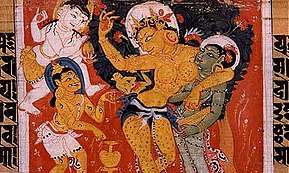
In the earliest Buddhist texts, the nikāyas and āgamas, the Buddha is not depicted as possessing omniscience (sabbaññu)[97] nor is he depicted as being an eternal transcendent (lokottara) being. According to Bhikkhu Analayo, ideas of the Buddha's omniscience (along with an increasing tendency to deify him and his biography) are found only later, in the Mahayana sutras and later Pali commentaries or texts such as the Mahāvastu.[97] In the Sandaka Sutta, the Buddha's disciple Ananda outlines an argument against the claims of teachers who say they are all knowing [98] while in the Tevijjavacchagotta Sutta the Buddha himself states that he has never made a claim to being omniscient, instead he claimed to have the "higher knowledges" (abhijñā).[99] The earliest biographical material from the Pali Nikayas focuses on the Buddha's life as a śramaṇa, his search for enlightenment under various teachers such as Alara Kalama and his forty-five-year career as a teacher.[100]
Traditional biographies of Gautama generally include numerous miracles, omens, and supernatural events. The character of the Buddha in these traditional biographies is often that of a fully transcendent (Skt. lokottara) and perfected being who is unencumbered by the mundane world. In the Mahāvastu, over the course of many lives, Gautama is said to have developed supramundane abilities including: a painless birth conceived without intercourse; no need for sleep, food, medicine, or bathing, although engaging in such "in conformity with the world"; omniscience, and the ability to "suppress karma".[101] As noted by Andrew Skilton, the Buddha was often described as being superhuman, including descriptions of him having the 32 major and 80 minor marks of a "great man," and the idea that the Buddha could live for as long as an aeon if he wished (see DN 16).[102]
The ancient Indians were generally unconcerned with chronologies, being more focused on philosophy. Buddhist texts reflect this tendency, providing a clearer picture of what Gautama may have taught than of the dates of the events in his life. These texts contain descriptions of the culture and daily life of ancient India which can be corroborated from the Jain scriptures, and make the Buddha's time the earliest period in Indian history for which significant accounts exist.[103] British author Karen Armstrong writes that although there is very little information that can be considered historically sound, we can be reasonably confident that Siddhārtha Gautama did exist as a historical figure.[104] Michael Carrithers goes a bit further by stating that the most general outline of "birth, maturity, renunciation, search, awakening and liberation, teaching, death" must be true.[105]
Previous lives
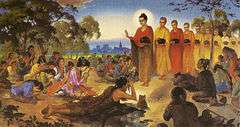
Legendary biographies like the Pali Buddhavaṃsa and the Sanskrit Jātakamālā depict the Buddha's (referred to as "bodhisattva" before his awakening) career as spanning hundreds of lifetimes before his last birth as Gautama. Many stories of these previous lives are depicted in the Jatakas.[106] The format of a Jataka typically begins by telling a story in the present which is then explained by a story of someone's previous life.[107]
Besides imbuing the pre-Buddhist past with a deep karmic history, the Jatakas also serve to explain the bodhisattva's (the Buddha-to-be) path to Buddhahood.[108] In biographies like the Buddhavaṃsa, this path is described as long and arduous, taking "four incalculable ages" (asamkheyyas).[109]
In these legendary biographies, the bodhisattva goes through many different births (animal and human), is inspired by his meeting of past Buddhas, and then makes a series of resolves or vows (pranidhana) to become a Buddha himself. Then he begins to receive predictions by past Buddhas.[110] One of the most popular of these stories is his meeting with Dipankara Buddha, who gives the bodhisattva a prediction of future Buddhahood.[111]
Another theme found in the Pali Jataka Commentary (Jātakaṭṭhakathā) and the Sanskrit Jātakamālā is how the Buddha-to-be had to practice several "perfections" (pāramitā) to reach Buddhahood.[112] The Jatakas also sometimes depict negative actions done in previous lives by the bodhisattva, which explain difficulties he experienced in his final life as Gautama.[113]
Biography
Birth and early life
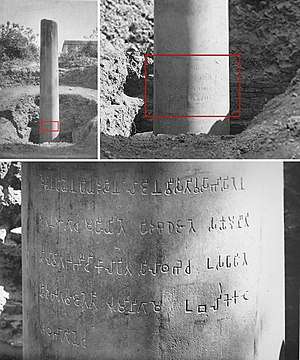
The Buddhist tradition regards Lumbini, in present-day Nepal to be the birthplace of the Buddha.[115][note 1] He grew up in Kapilavastu.[note 1] The exact site of ancient Kapilavastu is unknown.[116] It may have been either Piprahwa, Uttar Pradesh, in present-day India,[55] or Tilaurakot, in present-day Nepal.[117] Both places belonged to the Sakya territory, and are located only 15 miles (24 km) apart.[117]
The earliest Buddhist sources state that the Buddha was born to an aristocratic Kshatriya (Pali: khattiya) family called Gotama (Sanskrit: Gautama), who were part of the Shakyas, a tribe of rice-farmers living near the modern border of India and Nepal.[118][119][120][note 11] the son of Śuddhodana, "an elected chief of the Shakya clan",[7] whose capital was Kapilavastu, and who were later annexed by the growing Kingdom of Kosala during the Buddha's lifetime. Gautama was the family name. According to later biographies such as the Mahavastu and the Lalitavistara, his mother, Maya (Māyādevī), Suddhodana's wife, was a Koliyan princess. Legend has it that, on the night Siddhartha was conceived, Queen Maya dreamt that a white elephant with six white tusks entered her right side,[122][123] and ten months later[124] Siddhartha was born. As was the Shakya tradition, when his mother Queen Maya became pregnant, she left Kapilavastu for her father's kingdom to give birth. However, her son is said to have been born on the way, at Lumbini, in a garden beneath a sal tree.
The early Buddhist texts contain very little information about the birth and youth of Gotama Buddha.[125][126] Later biographies developed a dramatic narrative about the life of the young Gotama as a prince and his existential troubles.[127] They also depict his father Śuddhodana as a hereditary monarch of the Suryavansha (Solar dynasty) of Ikṣvāku (Pāli: Okkāka). This is unlikely however, as many scholars think that Śuddhodana was merely a Shakya aristocrat (khattiya), and that the Shakya republic was not a hereditary monarchy.[128][129][130] Indeed, the more egalitarian gana-sangha form of government, as a political alternative to Indian monarchies, may have influenced the development of the śramanic Jain and Buddhist sanghas, where monarchies tended toward Vedic Brahmanism.[131]
The day of the Buddha's birth is widely celebrated in Theravada countries as Vesak.[132] Buddha's Birthday is called Buddha Purnima in Nepal, Bangladesh, and India as he is believed to have been born on a full moon day.
According to later biographical legends, during the birth celebrations, the hermit seer Asita journeyed from his mountain abode, analyzed the child for the "32 marks of a great man" and then announced that he would either become a great king (chakravartin) or a great religious leader.[133][134] Suddhodana held a naming ceremony on the fifth day and invited eight Brahmin scholars to read the future. All gave similar predictions.[133] Kondañña, the youngest, and later to be the first arhat other than the Buddha, was reputed to be the only one who unequivocally predicted that Siddhartha would become a Buddha.[135]
Early texts suggest that Gautama was not familiar with the dominant religious teachings of his time until he left on his religious quest, which is said to have been motivated by existential concern for the human condition.[136] According to the early Buddhist Texts of several schools, and numerous post-canonical accounts, Gotama had a wife, Yasodhara, and a son, named Rāhula.[137] Besides this, the Buddha in the early texts reports that "'I lived a spoilt, a very spoilt life, monks (in my parents’ home)."[138]
The legendary biographies like the Lalitavistara also tell stories of young Gotama's great martial skill, which was put to the test in various contests against other Shakyan youths.[139]
Renunciation
While the earliest sources merely depict Gotama seeking a higher spiritual goal and becoming an ascetic or sramana after being disillusioned with lay life, the later legendary biographies tell a more elaborate dramatic story about how he became a mendicant.[127][140]
The earliest accounts of the Buddha's spiritual quest is found in texts such as the Pali Ariyapariyesanā-sutta ("The discourse on the noble quest," MN 26) and its Chinese parallel at MĀ 204.[141] These texts report that what led to Gautama's renunciation was the thought that his life was subject to old age, disease and death and that there might be something better (i.e. liberation, nirvana).[142] The early texts also depict the Buddha's explanation for becoming a sramana as follows: "The household life, this place of impurity, is narrow - the samana life is the free open air. It is not easy for a householder to lead the perfected, utterly pure and perfect holy life."[143] MN 26, MĀ 204, the Dharmaguptaka Vinaya and the Mahāvastu all agree that his mother and father opposed his decision and "wept with tearful faces" when he decided to leave.[144][145]
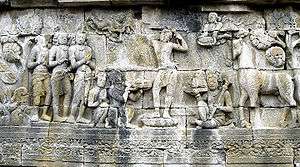
Legendary biographies also tell the story of how Gautama left his palace to see the outside world for the first time and how he was shocked by his encounter with human suffering.[146][147] The legendary biographies depict Gautama's father as shielding him from religious teachings and from knowledge of human suffering, so that he would become a great king instead of a great religious leader.[148] In the Nidanakatha (5th century CE), Gautama is said to have seen an old man. When his charioteer Chandaka explained to him that all people grew old, the prince went on further trips beyond the palace. On these he encountered a diseased man, a decaying corpse, and an ascetic that inspired him.[149][150][151] This story of the "four sights" seems to be adapted from an earlier account in the Digha Nikaya (DN 14.2) which instead depicts the young life of a previous Buddha, Vipassi.[151]
The legendary biographies depict Gautama's departure from his palace as follows. Shortly after seeing the four sights, Gautama woke up at night and saw his female servants lying in unattractive, corpse-like poses, which shocked him.[152] Therefore, he discovered what he would later understand more deeply during his enlightenment: suffering and the end of suffering.[153] Moved by all the things he had experienced, he decided to leave the palace in the middle of the night against the will of his father, to live the life of a wandering ascetic.[149] Accompanied by Chandaka and riding his horse Kanthaka, Gautama leaves the palace, leaving behind his son Rahula and Yaśodhara.[154] He traveled to the river Anomiya, and cut off his hair. Leaving his servant and horse behind, he journeyed into the woods and changed into monk's robes there,[155] though in some other versions of the story, he received the robes from a Brahma deity at Anomiya.[156]
According to the legendary biographies, when the ascetic Gautama first went to Rajagaha (present-day Rajgir) to beg for alms in the streets, King Bimbisara of Magadha learned of his quest, and offered him a share of his kingdom. Gautama rejected the offer but promised to visit his kingdom first, upon attaining enlightenment.[157][158]
Ascetic life and Awakening
All sources agree that the ascetic Gautama practised under two teachers of yogic meditation.[159][160][161] According to MN 26 and its Chinese parallel at MĀ 204, after having mastered the teaching of Ārāḍa Kālāma (Pali: Alara Kalama), who taught a meditation attainment called "the sphere of nothingness", he was asked by Ārāḍa to become an equal leader of their spiritual community.[162][163] However, Gautama felt unsatisfied by the practice because it "does not lead to revulsion, to dispassion, to cessation, to calm, to knowledge, to awakening, to Nibbana", and moved on to become a student of Udraka Rāmaputra (Pali: Udaka Ramaputta).[164][165] With him, he achieved high levels of meditative consciousness (called "The Sphere of Neither Perception nor Non-Perception") and was again asked to join his teacher. But, once more, he was not satisfied for the same reasons as before, and moved on.[166]
Majjhima Nikaya 4 also mentions that Gautama lived in "remote jungle thickets" during his years of spiritual striving and had to overcome the fear that he felt while living in the forests.[167]

After leaving his meditation teachers, Gotama then practiced ascetic techniques.[168] An account of these practices can be seen in the Mahāsaccaka-sutta (MN 36) and its various parallels (which according to Analayo include some Sanskrit fragments, an individual Chinese translation, a sutra of the Ekottarika-āgama as well as sections of the Lalitavistara and the Mahāvastu).[169] The ascetic techniques described in the early texts include very minimal food intake, different forms of breath control, and forceful mind control. The texts report that he became so emaciated that his bones became visible through his skin.[170]
According to other early Buddhist texts,[171] after realising that meditative dhyana was the right path to awakening, Gautama discovered "the Middle Way"—a path of moderation away from the extremes of self-indulgence and self-mortification, or the Noble Eightfold Path.[171] His break with asceticism is said to have led his five companions to abandon him, since they believed that he had abandoned his search and become undisciplined. One popular story tells of how he accepted milk and rice pudding from a village girl named Sujata.[172]
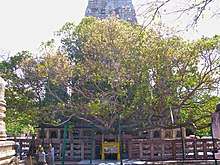
Following his decision to stop extreme ascetic practices, MĀ 204 and other parallel early texts report that Gautama sat down to meditate with the determination not to get up until full awakening (sammā-sambodhi) had been reached.[173] This event was said to have occurred under a pipal tree—known as "the Bodhi tree"—in Bodh Gaya, Bihar.[174]
Likewise, the Mahāsaccaka-sutta and most of its parallels agree that after taking asceticism to its extremes, the Buddha realized that this had not helped him reach awakening. At this point, he remembered a previous meditative experience he had as a child sitting under a tree while his father worked.[175] This memory leads him to understand that dhyana (meditation) is the path to awakening, and the texts then depict the Buddha achieving all four dhyanas, followed by the "three higher knowledges" (tevijja) culminating in awakening.[176]

Gautama thus became known as the Buddha or "Awakened One". The title indicates that unlike most people who are "asleep", a Buddha is understood as having "woken up" to the true nature of reality and sees the world 'as it is' (yatha-bhutam).[11] A Buddha has achieved liberation (vimutti), also called Nirvana, which is seen as the extinguishing of the "fires" of desire, hatred, and ignorance, that keep the cycle of suffering and rebirth going.[178] According to various early texts like the Mahāsaccaka-sutta, and the Samaññaphala Sutta, a Buddha has achieved three higher knowledges: Remembering one's former abodes (i.e. past lives), the "Divine eye" (dibba-cakkhu), which allows the knowing of others' karmic destinations and the "extinction of mental intoxicants" (āsavakkhaya).[170][179]
According to some texts from the Pali canon, at the time of his awakening he realised complete insight into the Four Noble Truths, thereby attaining liberation from samsara, the endless cycle of rebirth.[180][181][182] [note 12]
As reported by various texts from the Pali Canon, the Buddha sat for seven days under the bodhi tree "feeling the bliss of deliverance."[183] The Pali texts also report that he continued to meditate and contemplated various aspects of the Dharma while living by the River Nairañjanā, such as Dependent Origination, the Five Spiritual Faculties and Suffering.[184]
The legendary biographies like the Mahavastu and the Lalitavistara depict an attempt by Mara, the Lord of the desire realm, to prevent the Buddha's nirvana. He does so by sending his daughters to seduce the Buddha, by asserting his superiority and by assaulting him with armies of monsters.[185] However the Buddha is unfazed and calls on the earth (or in some versions of the legend, the earth goddess) as witness to his superiority by touching the ground before entering meditation.[186] Other miracles and magical events are also depicted.
First sermon and formation of the saṅgha
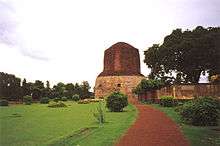
According to MN 26, immediately after his awakening, the Buddha hesitated on whether or not he should teach the Dharma to others. He was concerned that humans were so overpowered by ignorance, greed, and hatred that they could never recognise the path, which is "subtle, deep and hard to grasp." However, the god Brahmā Sahampati convinced him, arguing that at least some "with little dust in their eyes" will understand it. The Buddha relented and agreed to teach. According to Analayo, the Chinese parallel to MN 26, MĀ 204, does not contain this story, but this event does appear in other parallel texts, such as in an Ekottarika-āgama discourse, in the Catusparisat-sūtra, and in the Lalitavistara.[173]
According to MN 26 and MĀ 204, after deciding to teach, the Buddha initially intended to visit his former teachers, Alara Kalama and Udaka Ramaputta, to teach them his insights, but they had already died, so he decided to visit his five former companions.[187] MN 26 and MĀ 204 both report that on his way to Vārānasī (Benares), he met another wanderer, called Ājīvika Upaka in MN 26. The Buddha proclaimed that he had achieved full awakening, but Upaka was not convinced and "took a different path".[188]
MN 26 and MĀ 204 continue with the Buddha reaching the Deer Park (Sarnath) (Mrigadāva, also called Rishipatana, "site where the ashes of the ascetics fell")[189] near Vārānasī , where he met the group of five ascetics and was able to convince them that he had indeed reached full awakening.[190] According to MĀ 204 (but not MN 26), as well as the Theravāda Vinaya, an Ekottarika-āgama text, the Dharmaguptaka Vinaya, the Mahīśāsaka Vinaya, and the Mahāvastu, the Buddha then taught them the "first sermon", also known as the "Benares sermon"[189], i.e. the teaching of "the noble eightfold path as the middle path aloof from the two extremes of sensual indulgence and self-mortification."[190] The Pali text reports that after the first sermon, the ascetic Koṇḍañña (Kaundinya) became the first arahant (liberated being) and the first Buddhist bhikkhu or monastic.[191] The Buddha then continued to teach the other ascetics and they formed the first saṅgha: the company of Buddhist monks.
Various sources such as the Mahāvastu, the Mahākhandhaka of the Theravāda Vinaya and the Catusparisat-sūtra also mention that the Buddha taught them his second discourse, about the characteristic of "not-self" (Anātmalakṣaṇa Sūtra), at this time[192] or five days later.[189] After hearing this second sermon the four remaining ascetics also reached the status of arahant.[189]
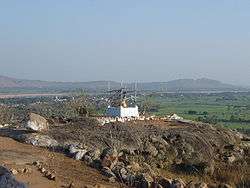
The Theravāda Vinaya and the Catusparisat-sūtra also speak of the conversion of Yasa, a local guild master, and his friends and family, who were some of the first laypersons to be converted and to enter the Buddhist community.[193][189] The conversion of three brothers named Kassapa followed, who brought with them five hundred converts who had previously been "matted hair ascetics," and whose spiritual practice was related to fire sacrifices.[194][195] According to the Theravāda Vinaya, the Buddha then stopped at the Gayasisa hill near Gaya and delivered his third discourse, the Ādittapariyāya Sutta (The Discourse on Fire),[196] in which he taught that everything in the world is inflamed by passions and only those who follow the Eightfold path can be liberated.[189]
At the end of the rainy season, when the Buddha's community had grown to around sixty awakened monks, he instructed them to wander on their own, teach and ordain people into the community, for the "welfare and benefit" of the world.[197][189]
The growth of the saṅgha
For the remaining 40 or 45 years of his life, the Buddha is said to have traveled in the Gangetic Plain, in what is now Uttar Pradesh, Bihar, and southern Nepal, teaching a diverse range of people: from nobles to servants, ascetics and householders, murderers such as Angulimala, and cannibals such as Alavaka.[198][140][9] According to Schumann, the Buddha's wanderings ranged from "Kosambi on the Yamuna (25 km south-west of Allahabad )", to Campa (40 km east of Bhagalpur)" and from "Kapilavatthu (95 km north-west of Gorakhpur) to Uruvela (south of Gaya)." This covers an area of 600 by 300 km.[199] His sangha enjoyed the patronage of the kings of Kosala and Magadha and he thus spent a lot of time in their respective capitals, Savatthi and Rajagaha.[199]
Although the Buddha's language remains unknown, it is likely that he taught in one or more of a variety of closely related Middle Indo-Aryan dialects, of which Pali may be a standardisation.
The sangha traveled through the subcontinent, expounding the Dharma. This continued throughout the year, except during the four months of the Vassa rainy season when ascetics of all religions rarely traveled. One reason was that it was more difficult to do so without causing harm to flora and animal life.[200] The health of the ascetics might have been a concern as well.[201] At this time of year, the sangha would retreat to monasteries, public parks or forests, where people would come to them.
The first vassana was spent at Varanasi when the sangha was formed. According to the Pali texts, shortly after the formation of the sangha, the Buddha traveled to Rajagaha, capital of Magadha, and met with King Bimbisara, who gifted a bamboo grove park to the sangha.[202]
The Buddha's sangha continued to grow during his initial travels in north India. The early texts tell the story of how the Buddha's chief disciples, Sāriputta and Mahāmoggallāna, who were both students of the skeptic sramana Sañjaya Belaṭṭhiputta, were converted by Assaji.[203][204] They also tell of how the Buddha's son, Rahula, joined his father as a bhikkhu when the Buddha visited his old home, Kapilavastu.[205] Over time, other Shakyans joined the order as bhikkhus, such as Buddha's cousin Ananda, Anuruddha, Upali the barber, the Buddha's half-brother Nanda and Devadatta.[206][207] Meanwhile, the Buddha's father Suddhodana heard his son's teaching, converted to Buddhism and became a stream-enterer.
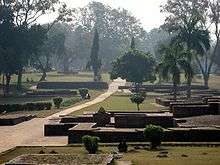
The early texts also mention an important lay disciple, the merchant Anāthapiṇḍika, who became a strong lay supporter of the Buddha early on. He is said to have gifted Jeta's grove (Jetavana) to the sangha at great expense (the Theravada Vinaya speaks of thousands of gold coins).[208][209]
Formation of the bhikkhunī order
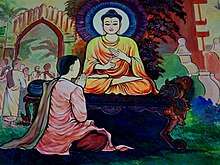
The formation of a parallel order of female monastics (bhikkhunī) was another important part of the growth of the Buddha's community. As noted by Analayo's comparative study of this topic, there are various versions of this event depicted in the different early Buddhist texts.[210]
According to all the major versions surveyed by Analayo, Mahāprajāpatī Gautamī, Buddha's step-mother, is initially turned down by the Buddha after requesting ordination for her and some other women. Mahāprajāpatī and her followers then shave their hair, don robes and begin following the Buddha on his travels. The Buddha is eventually convinced by Ānanda to grant ordination to Mahāprajāpatī on her acceptance of eight conditions called gurudharmas which focus on the relationship between the new order of nuns and the monks.[211]
According to Analayo, the only argument common to all the versions that Ananda uses to convince the Buddha is that women have the same ability to reach all stages of awakening.[212] Analayo also notes that some modern scholars have questioned the authenticity of the eight gurudharmas in their present form due to various inconsistencies. He holds that the historicity of the current lists of eight is doubtful, but that they may have been based on earlier injunctions by the Buddha.[213][214] Analayo also notes that various passages indicate that the reason for the Buddha's hesitation to ordain women was the danger that the life of a wandering sramana posed for women that were not under the protection of their male family members (such as dangers of sexual assault and abduction). Due to this, the gurudharma injunctions may have been a way to place "the newly founded order of nuns in a relationship to its male counterparts that resembles as much as possible the protection a laywoman could expect from her male relatives."[215]
Later years
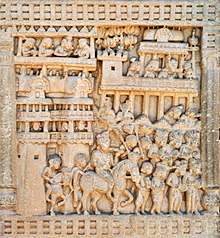
According to J.S. Strong, after the first 20 years of his teaching career, the Buddha seems to have slowly settled in Sravasti, the capital of the Kingdom of Kosala, spending most of his later years in this city.[209]
As the sangha grew in size, the need for a standardized set of monastic rules arose and the Buddha seems to have developed a set of regulations for the sangha. These are preserved in various texts called "Pratimoksa" which were recited by the community every fortnight. The Pratimoksa includes general ethical precepts, as well as rules regarding the essentials of monastic life, such as bowls and robes.[217]
In his later years, the Buddha's fame grew and he was invited to important royal events, such as the inauguration of the new council hall of the Shakyans (as seen in MN 53) and the inauguration of a new palace by Prince Bodhi (as depicted in MN 85).[218] The early texts also speak of how during the Buddha's old age, the kingdom of Magadha was usurped by a new king, Ajatasattu, who overthrew his father Bimbisara. According to the Samaññaphala Sutta, the new king spoke with different ascetic teachers and eventually took refuge in the Buddha.[219] However, Jain sources also claim his allegiance, and it is likely he supported various religious groups, not just the Buddha's sangha exclusively.[220]
As the Buddha continued to travel and teach, he also came into contact with members of other śrāmana sects. There is evidence from the early texts that the Buddha encountered some of these figures and critiqued their doctrines. The Samaññaphala Sutta identifies six such sects.[221]
The early texts also depict the elderly Buddha as suffering from back pain. Several texts depict him delegating teachings to his chief disciples since his body now needed more rest.[222] However, the Buddha continued teaching well into his old age.
One of the most troubling events during the Buddha's old age was Devadatta's schism. Early sources speak of how the Buddha's cousin, Devadatta, attempted to take over leadership of the order and then left the sangha with several Buddhist monks and formed a rival sect. This sect is said to have also been supported by King Ajatasattu.[223][224] The Pali texts also depict Devadatta as plotting to kill the Buddha, but these plans all fail.[225] They also depict the Buddha as sending his two chief disciples (Sariputta and Moggallana) to this schismatic community in order to convince the monks who left with Devadatta to return.[226]
All the major early Buddhist Vinaya texts depict Devadatta as a divisive figure who attempted to split the Buddhist community, but they disagree on what issues he disagreed with the Buddha on. The Sthavira texts generally focus on "five points" which are seen as excessive ascetic practices, while the Mahāsaṅghika Vinaya speaks of a more comprehensive disagreement, which has Devadatta alter the discourses as well as monastic discipline.[227]
At around the same time of Devadatta's schism, there was also war between Ajatasattu's Kingdom of Magadha, and Kosala, led by an elderly king Pasenadi.[228] Ajatasattu seems to have been victorious, a turn of events the Buddha is reported to have regretted.[229]
Last days and parinirvana
.jpg)
The main narrative of the Buddha's last days, death and the events following his death is contained in the Mahaparinibbana Sutta (DN 16) and its various parallels in Sanskrit, Chinese, and Tibetan.[230] According to Analayo, these include the Chinese Dirgha Agama 2, "Sanskrit fragments of the Mahaparinirvanasutra", and "three discourses preserved as individual translations in Chinese".[231]
The Mahaparinibbana sutta depicts the Buddha's last year as a time of war. It begins with Ajatasattu's decision to make war on the Vajjian federation, leading him to send a minister to ask the Buddha for advice.[232] The Buddha responds by saying that the Vajjians can be expected to prosper as long as they do seven things, and he then applies these seven principles to the Buddhist Sangha, showing that he is concerned about its future welfare. The Buddha says that the Sangha will prosper as long as they "hold regular and frequent assemblies, meet in harmony, do not change the rules of training, honor their superiors who were ordained before them, do not fall prey to worldly desires, remain devoted to forest hermitages, and preserve their personal mindfulness." He then gives further lists of important virtues to be upheld by the Sangha.[233]
The early texts also depict how the Buddha's two chief disciples, Sariputta and Moggallana, died just before the Buddha's death.[234] The Mahaparinibbana depicts the Buddha as experiencing illness during the last months of his life but initially recovering. It also depicts him as stating that he cannot promote anyone to be his successor. When Ānanda requested this, the Mahaparinibbana records his response as follows:[235]
Ananda, why does the Order of monks expect this of me? I have taught the Dhamma, making no distinction of “inner” and “ outer”: the Tathagata has no “teacher’s fist” (in which certain truths are held back). If there is anyone who thinks: “I shall take charge of the Order”, or “the Order is under my leadership”, such a person would have to make arrangements about the Order. The Tathagata does not think in such terms. Why should the Tathagata make arrangements for the Order? I am now old, worn out . . . I have reached the term of life, I am turning eighty years of age. Just as an old cart is made to go by being held together with straps, so the Tathagata's body is kept going by being bandaged up . . . Therefore, Ananda, you should live as islands unto yourselves, being your own refuge, seeking no other refuge; with the Dhamma as an island, with the Dhamma as your refuge, seeking no other refuge. . . Those monks who in my time or afterwards live thus, seeking an island and a refuge in themselves and in the Dhamma and nowhere else, these zealous ones are truly my monks and will overcome the darkness (of rebirth).
%2C_Gandhara%2C_3rd_or_4th_century_AD%2C_gray_schist_-_John_and_Mable_Ringling_Museum_of_Art_-_Sarasota%2C_FL_-_DSC00665.jpg)
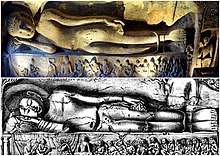
After traveling and teaching some more, the Buddha ate his last meal, which he had received as an offering from a blacksmith named Cunda. Falling violently ill, Buddha instructed his attendant Ānanda to convince Cunda that the meal eaten at his place had nothing to do with his death and that his meal would be a source of the greatest merit as it provided the last meal for a Buddha.[236] Mettanando and von Hinüber argue that the Buddha died of mesenteric infarction, a symptom of old age, rather than food poisoning.[237][238]
The precise contents of the Buddha's final meal are not clear, due to variant scriptural traditions and ambiguity over the translation of certain significant terms. The Theravada tradition generally believes that the Buddha was offered some kind of pork, while the Mahayana tradition believes that the Buddha consumed some sort of truffle or other mushroom. These may reflect the different traditional views on Buddhist vegetarianism and the precepts for monks and nuns.[239] Modern scholars also disagree on this topic, arguing both for pig's flesh or some kind of plant or mushroom that pigs like to eat.[note 13] Whatever the case, none of the sources which mention the last meal attribute the Buddha's sickness to the meal itself.[240]
As per the Mahaparinibbana sutta, after the meal with Cunda, the Buddha and his companions continued traveling until he was too weak to continue and had to stop at Kushinagar, where Ānanda had a resting place prepared in a grove of Sala trees.[241][242] After announcing to the sangha at large that he would soon be passing away to final Nirvana, the Buddha ordained one last novice into the order personally, his name was Subhadda.[241] He then repeated his final instructions to the sangha, which was that the Dhamma and Vinaya was to be their teacher after his death. Then he asked if anyone had any doubts about the teaching, but nobody did.[243] The Buddha's final words are reported to have been: "All saṅkhāras decay. Strive for the goal with diligence (appamāda)" (Pali: 'vayadhammā saṅkhārā appamādena sampādethā').[244][245]
He then entered his final meditation and died, reaching what is known as parinirvana (final nirvana, the end of rebirth and suffering achieved after the death of the body). The Mahaparinibbana reports that in his final meditation he entered the four dhyanas consecutively, then the four immaterial attainments and finally the meditative dwelling known as nirodha-samāpatti, before returning to the fourth dhyana right at the moment of death.[246][242]
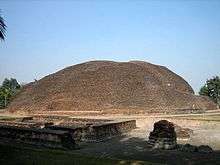

Posthumous events
According to the Mahaparinibbana sutta, the Mallians of Kushinagar spent the days following the Buddha's death honoring his body with flowers, music and scents.[247] The sangha waited until the eminent elder Mahākassapa arrived to pay his respects before cremating the body.[248]
The Buddha's body was then cremated and the remains, including his bones, were kept as relics and they were distributed among various north Indian kingdoms like Magadha, Shakya and Koliya.[249] These relics were placed in monuments or mounds called stupas, a common funerary practice at the time. Centuries later they would be exhumed and enshrined by Ashoka into many new stupas around the Mauryan realm.[250][251] Many supernatural legends surround the history of alleged relics as they accompanied the spread of Buddhism and gave legitimacy to rulers.
According to various Buddhist sources, the First Buddhist Council was held shortly after the Buddha's death to collect, recite and memorize the teachings. Mahākassapa was chosen by the sangha to be the chairman of the council. However, the historicity of the traditional accounts of the first council is disputed by modern scholars.[252]
Teachings
Tracing the oldest teachings
One method to obtain information on the oldest core of Buddhism is to compare the oldest versions of the Pali Canon and other texts, such as the surviving portions of Sarvastivada, Mulasarvastivada, Mahisasaka, Dharmaguptaka,[253][254] and the Chinese Agamas.[255][256] The reliability of these sources, and the possibility of drawing out a core of oldest teachings, is a matter of dispute.[257][258][259][260] According to Tilmann Vetter, inconsistencies remain, and other methods must be applied to resolve those inconsistencies.[253][note 14]
According to Lambert Schmithausen, there are three positions held by modern scholars of Buddhism:[263]
- "Stress on the fundamental homogeneity and substantial authenticity of at least a considerable part of the Nikayic materials."[note 15]
- "Scepticism with regard to the possibility of retrieving the doctrine of earliest Buddhism."[note 16][note 17]
- "Cautious optimism in this respect."[note 18]
Regarding their attribution to the historical Buddha Gautama "Sakyamuni", scholars such as Richard Gombrich, Akira Hirakawa, Alexander Wynne and A.K. Warder hold that these Early Buddhist Texts contain material that could possibly be traced to this figure.[268][269][142]
Influences
.jpg)
According to scholars of Indology such as Richard Gombrich, the Buddha's teachings on Karma and Rebirth are a development of pre-Buddhist themes that can be found in Jain and Brahmanical sources, like the Brihadaranyaka Upanishad.[270] Likewise, samsara, the idea that we are trapped in cycle of rebirth and that we should seek liberation from this through non-harming (ahimsa) and spiritual practices, pre-dates the Buddha and was likely taught in early Jainism.[271]
In various texts, the Buddha is depicted as having studied under two named teachers, Āḷāra Kālāma and Uddaka Rāmaputta. According to Alexander Wynne, these were yogis who taught doctrines and practices similar to those in the Upanishads.[272]
The Buddha's tribe of origin, the Shakyas, also seem to have had non-Vedic religious practices which influenced Buddhism, such as the veneration of trees and sacred groves, and the worship of tree spirits (yakkhas) and serpent beings (nagas). They also seem to have built burial mounds called stupas.[273]
Tree veneration remains important in Buddhism today, particularly in the practice of venerating Bodhi trees. Likewise, yakkas and nagas have remained important figures in Buddhist religious practices and mythology.[273]
In the Early Buddhist Texts, the Buddha also references Brahmanical devices. For example, in Samyutta Nikaya 111, Majjhima Nikaya 92 and Vinaya i 246 of the Pali Canon, the Buddha praises the Agnihotra as the foremost sacrifice and the Gayatri mantra as the foremost meter.[note 19]
The Buddhist teaching of the three marks of existence[note 20] may also reflect Upanishadic or other influences according to K.R. Norman.[275]
According to Johannes Bronkhorst, the "meditation without breath and reduced intake of food" which the Buddha practiced before his awakening are forms of asceticism which are similar to Jain practices.[276]
The Buddhist practice called Brahma-vihara may have also originated from a Brahmanic term;[277] but its usage may have been common in the sramana traditions.[257]
Teachings preserved in the Early Buddhist Texts
%2C_part_31_-_BL_Or._14915.jpg)
The Early Buddhist Texts present many teachings and practices which may have been taught by the historical Buddha. These include basic doctrines such as Dependent Origination, the Middle Way, the Five Aggregates, the Three unwholesome roots, the Four Noble Truths and the Eightfold Path. According to N. Ross Reat, all of these doctrines are shared by the Theravada Pali texts and the Mahasamghika school's Śālistamba Sūtra.[278]
A recent study by Bhikkhu Analayo concludes that the Theravada Majjhima Nikaya and Sarvastivada Madhyama Agama contain mostly the same major doctrines.[279] Likewise, Richard Salomon has written that the doctrines found in the Gandharan Manuscripts are "consistent with non-Mahayana Buddhism, which survives today in the Theravada school of Sri Lanka and Southeast Asia, but which in ancient times was represented by eighteen separate schools."[280]
These basic teachings such as the Four Noble Truths tend to be widely accepted as basic doctrines in all major schools of Buddhism, as seen in ecumenical documents such as the Basic points unifying Theravāda and Mahāyāna.
Critique of Brahmanism
.jpg)
In the early Buddhist texts, the Buddha critiques the Brahmanical religion and social system on certain key points.
The brahmin caste held that the Vedas were eternal revealed (sruti) texts. The Buddha, on the other hand, did not accept that these texts had any divine authority or value.[281]
The Buddha also did not see the Brahmanical rites and practices as useful for spiritual advancement. For example, in the Udāna, the Buddha points out that ritual bathing does not lead to purity, only "truth and morality" lead to purity.[note 21] He especially critiqued animal sacrifice as taught in Vedas.[281] The Buddha contrasted his teachings, which were taught openly to all people, with that of the Brahmins', who kept their mantras secret.[note 22]
He also critiqued numerous other brahmanical practices, such astrology, divination, fortune-telling, and so on (as seen in the Tevijja sutta and the Kutadanta sutta).[283]
The Buddha also attacked the brahmins' claims of superior birth and the idea that different castes and bloodlines were inherently pure or impure, noble or ignoble.[281]
In the Vasettha sutta the Buddha argues that the main difference among humans is not birth but their actions and occupations.[284] According to the Buddha, one is a "brahmin" (i.e. divine, like brahma) only to the extent that one has cultivated virtue.[note 23] Because of this the early texts report that he proclaimed: "Not by birth one is a brahman, not by birth one is a non-brahman; - by moral action one is a brahman"[281]
The Aggañña Sutta explains all classes or varnas can be good or bad and gives a sociological explanation for how they arose, against the Brahmanical idea that they are divinely ordained.[285] According to Kancha Ilaiah, the Buddha posed the first contract theory of society.[286] The Buddha's teaching then is a single universal moral law, one Dharma valid for everybody, which is opposed to the Brahmanic ethic founded on “one’s own duty” (svadharma) which depends on caste.[281] Because of this, all castes including untouchables were welcome in the Buddhist order and when someone joined, they renounced all caste affiliation.[287][288]
Analysis of existence
The early Buddhist texts present the Buddha's worldview as focused on understanding the nature of dukkha, which is seen as the fundamental problem of life.[289] Dukkha refers to all kinds of suffering, unease, frustration, and dissatisfaction that sentient beings experience.[290][291] At the core of the Buddha's analysis of dukkha is the fact that everything we experience is impermanent, unstable and thus unreliable.[292]
A common presentation of the core structure of Buddha's teaching found in the early texts is that of the Four Noble Truths.[293] This teaching is most famously presented in the Dhammacakkappavattana Sutta ("The discourse on the turning of the Dharma wheel") and its many parallels.[294] The basic outline of the four truths is as follows:[293][290]
- There is dukkha.
- There are causes and conditions for the arising of dukkha. Various conditions are outlined in the early texts, such as craving (taṇhā), but the three most basic ones are greed, aversion and delusion.[295]
- If the conditions for dukkha cease, dukkha also ceases. This is "Nirvana" (literally 'blowing out' or 'extinguishing').[296]
- There is path to follow that leads to Nirvana.
According to Bhikkhu Analayo, the four truths schema appears to be based "on an analogy with Indian medical diagnosis" (with the form: "disease, pathogen, health, cure") and this comparison is "explicitly made in several early Buddhist texts".[294]
In another Pali sutta, the Buddha outlines how "eight worldly conditions", "keep the world turning around...Gain and loss, fame and disrepute, praise and blame, pleasure and pain." He then explains how the difference between a noble (arya) person and an uninstructed worldling is that a noble person reflects on and understands the impermanence of these conditions.[297]
The Buddha's analysis of existence includes an understanding that karma and rebirth are part of life. According to the Buddha, the constant cycle of dying and being reborn (i.e. saṃsāra) according to one's karma is just dukkha and the ultimate spiritual goal should be liberation from this cycle.[298] According to the Pali suttas, the Buddha stated that "this saṃsāra is without discoverable beginning. A first point is not discerned of beings roaming and wandering on hindered by ignorance and fettered by craving."[299]
The Buddha's teaching of karma differed to that of the Jains and Brahmins, in that on his view, karma is primarily mental intention (as opposed to mainly physical action or ritual acts).[290] The Buddha is reported to have said "By karma I mean intention."[300] Richard Gombrich summarizes the Buddha's view of karma as follows: "all thoughts, words, and deeds derive their moral value, positive or negative, from the intention behind them."[301]
For the Buddha, our karmic acts also affected the rebirth process in a positive or negative way. This was seen as an impersonal natural law similar to how certain seeds produce certain plants and fruits (in fact, the result of a karmic act was called its "fruit" by the Buddha).[302] However, it is important to note that the Buddha did not hold that everything that happens is the result of karma alone. In fact when the Buddha was asked to state the causes of pain and pleasure he listed various physical and environmental causes alongside karma.[303]
Dependent Origination

In the early texts, the process of the arising of dukkha is most thoroughly explained by the Buddha through the teaching of Dependent Origination.[290] At its most basic level, Dependent Origination is an empirical teaching on the nature of phenomena which says that nothing is experienced independently of its conditions.[304]
The most basic formulation of Dependent Origination is given in the early texts as: 'It being thus, this comes about' (Pali: evam sati idam hoti).[305] This can be taken to mean that certain phenomena only arise when there are other phenomena present (example: when there is craving, suffering arises), and so, one can say that their arising is "dependent" on other phenomena. In other words, nothing in experience exists without a cause.[305]
In numerous early texts, this basic principle is expanded with a list of phenomena that are said to be conditionally dependent.[306][note 24] These phenomena are supposed to provide an analysis of the cycle of dukkha as experienced by sentient beings. The philosopher Mark Siderits has outlined the basic idea of the Buddha's teaching of Dependent Origination of dukkha as follows:
given the existence of a fully functioning assemblage of psycho-physical elements (the parts that make up a sentient being), ignorance concerning the three characteristics of sentient existence—suffering, impermanence and non-self—will lead, in the course of normal interactions with the environment, to appropriation (the identification of certain elements as ‘I’ and ‘mine’). This leads in turn to the formation of attachments, in the form of desire and aversion, and the strengthening of ignorance concerning the true nature of sentient existence. These ensure future rebirth, and thus future instances of old age, disease and death, in a potentially unending cycle.[290]
The Buddha saw his analysis of Dependent Origination as a "Middle Way" between "eternalism" (sassatavada, the idea that some essence exists eternally) and "annihilationism" (ucchedavada, the idea that we go completely out of existence at death).[290][305] This middle way is basically the view that, conventionally speaking, persons are just a causal series of impermanent psycho-physical elements.[290]
Metaphysics and personal identity
Closely connected to the idea that experience is dependently originated is the Buddha's teaching that there is no independent or permanent self (Sanskrit: atman, Pali: atta).[304]
Due to this view which (termed anatta), the Buddha's teaching was opposed to all soul theories of his time, including the Jain theory of a "jiva" ("life monad") and the Brahmanical theories of atman and purusha. All of these theories held that there was an eternal unchanging essence to a person which transmigrated from life to life.[307][308][290]
While Brahminical teachers affirmed atman theories in an attempt to answer the question of what really exists ultimately, the Buddha saw this question as not being useful, as illustrated in the parable of the poisoned arrow.[309]
For the Buddha's contemporaries, the atman was also seen to be the unchanging constant which was separate from all changing experiences and the inner controller in a person.[310] The Buddha instead held that all things in the world of our experience are transient and that there is no unchanging part to a person.[311] According to Richard Gombrich, the Buddha's position is simply that "everything is process".[312] However, this anti-essentialist view still includes an understanding of continuity through rebirth, it is just the rebirth of a process (karma), not an essence like the atman.[313]
Perhaps the most important way the Buddha analyzed individual experience in the early texts was by way of the five 'aggregates' or 'groups' (khandha) of physical and mental processes.[314][315] The Buddha's arguments against an unchanging self rely on these five aggregate schema, as can be seen in the Pali Anattalakkhaṇa Sutta (and its parallels in Gandhari and Chinese).[316][317][318]
According to the early texts, the Buddha argued that because we have no ultimate control over any of the psycho-physical processes that make up a person, there cannot be an "inner controller" with command over them. Also, since they are all impermanent, one cannot regard any of the psycho-physical processes as an unchanging self.[319][290] Even mental processes such as consciousness and will (cetana) are seen as being dependently originated and impermanent and thus do not qualify as a self (atman).[290]
As noted by Gombrich, in the early texts the Buddha teaches that all five aggregates, including consciousness (viññana, which was held by Brahmins to be eternal), arise dependent on causes.[320] That is, existence is based on processes that are subject to dependent origination. He compared samsaric existence to a fire, which is dynamic and requires fuel (the khandas, literally: "heaps") in order to keep burning.[321]
As Rupert Gethin explains, for the Buddha:
I am a complex flow of physical and mental phenomena, but peel away these phenomena and look behind them and one just does not find a constant self that one can call one's own. My sense of self is both logically and emotionally just a label that I impose on these physical and mental phenomena in consequence of their connectedness.[322]
The Buddha saw the belief in a self as arising from our grasping at and identifying with the various changing phenomena, as well as from ignorance about how things really are.[323] Furthermore, the Buddha held that we experience suffering because we hold on to erroneous self views.[324][325]
Worldly happiness
As noted by Bhikkhu Bodhi, the Buddha as depicted in the Pali suttas does not exclusively teach a world transcending goal, but also teaches laypersons how to achieve worldly happiness (sukha).[326]
According to Bodhi, the "most comprehensive" of the suttas that focus on how to live as a layperson is the Sigālovāda Sutta (DN 31). This sutta outlines how a layperson behaves towards six basic social relationships: "parents and children, teacher and pupils, husband and wife, friend and friend, employer and workers, lay follower and religious guides." [327] This Pali text also has parallels in Chinese and in Sanskrit fragments.[328][329]
In another sutta (Dīghajāṇu Sutta, AN 8.54) the Buddha teaches two types of happiness. First, there is the happiness visible in this very life. The Buddha states that four things lead to this happiness: "The accomplishment of persistent effort, the accomplishment of protection, good friendship, and balanced living."[330] Similarly, in several other suttas, the Buddha teaches on how to improve family relationships, particularly on the importance of filial love and gratitude as well as marital well-being.[331]
Regarding the happiness of the next life, the Buddha (in the Dīghajāṇu Sutta) states that the virtues which lead to a good rebirth are: faith (in the Buddha and the teachings), moral discipline, especially keeping the five precepts, generosity, and wisdom (knowledge of the arising and passing of things).[332]
According to the Buddha of the suttas then, achieving a good rebirth is based on cultivating wholesome or skillful (kusala) karma, which leads to a good result, and avoiding unwholesome (akusala) karma. A common list of good karmas taught by the Buddha is the list of ten courses of action (kammapatha) as outlined in MN 41 Saleyyaka Sutta (and its Chinese parallel in SĀ 1042).[333][334]
Good karma is also termed merit (puñña), and the Buddha outlines three bases of meritorious actions: giving, moral discipline and meditation (as seen in AN 8:36).[335]
The Path to Liberation

.jpg)
Liberation (vimutti) from the ignorance and grasping which create suffering is not easily achieved because all beings have deeply entrenched habits (termed āsavas, often translated as "influxes" or "defilements") that keep them trapped in samsara. Because of this, the Buddha taught a path (marga) of training to undo such habits.[290][336] This path taught by the Buddha is depicted in the early texts (most famously in the Pali Dhammacakkappavattana Sutta and its numerous parallel texts) as a "Middle Way" between sensual indulgence on one hand and mortification of the body on the other.[294]
One of the most common formulations of the path to liberation in the earliest Buddhist texts is the Noble Eightfold Path.[337][note 25] There is also an alternative formulation with ten elements which is also very commonly taught in the early texts.[339]
According to Gethin, another common summary of the path to awakening wisely used in the early texts is "abandoning the hindrances, practice of the four establishments of mindfulness and development of the awakening factors."[340]
The early texts also contain many different presentations of the Buddha's path to liberation aside from the Eightfold Path.[341] According to Rupert Gethin, in the Nikayas and Agamas, the Buddha's path is mainly presented in a cumulative and gradual "step by step" process, such as that outlined in the Samaññaphala Sutta.[342][note 26] Early texts that outline the graduated path include the Cula-Hatthipadopama-sutta (MN 27, with Chinese parallel at MĀ 146) and the Tevijja Sutta (DN 13, with Chinese parallel at DĀ 26 and a fragmentary Sanskrit parallel entitled the Vāsiṣṭha-sūtra).[341][344][345] Other early texts like the Upanisa sutta (SN 12.23), present the path as reversions of the process of Dependent Origination.[346][note 27]
Some common practices which are shared by most of these early presentations of the path include sila (ethical training), restraint of the senses (indriyasamvara), mindfulness and clear awareness (sati-sampajañña) and the practice of jhana (meditative absorption).[339] Mental development (citta bhāvanā) was central to the Buddha's spiritual path as depicted in the earliest texts and this included meditative practices.
Regarding the training of right view and sense restraint, the Buddha taught that it was important to reflect on the dangers or drawbacks (adinava) of sensual pleasures. Various suttas discuss the different drawbacks of sensuality. In the Potaliya Sutta (MN 54) sensual pleasures are said by the Buddha to be a cause of conflict for all humans beings.[348] They are said to be unable to satisfy one's craving, like a clean meatless bone given to a dog.[349] Sensuality is also compared to a torch held against the wind, since it burns the person holding on to it.[350] According to the Buddha, there is "a delight apart from sensual pleasures, apart from unwholesome states, which surpasses even divine bliss." The Buddha thus taught that one should take delight in the higher spiritual pleasures instead of sensual pleasure.[351] This is explained with the simile the leper, who cauterizes his skin with fire to get relief from the pain of leprosy, but after he is cured, avoids the same flames he used to enjoy before (see MN 75, Magandiya Sutta).[352]
Numerous scholars such as Vetter have written on the centrality of the practice of dhyāna to the teaching of the Buddha.[353] It is the training of the mind, commonly translated as meditation, to withdraw the mind from the automatic responses to sense-impressions, and leading to a "state of perfect equanimity and awareness (upekkhā-sati-parisuddhi)."[354] Dhyana is preceded and supported by various aspects of the path such as seclusion and sense restraint.[355]
Another important mental training in the early texts is the practice of mindfulness (sati), which was mainly taught using the schemas of the "Four Ways of Mindfulness" (Satipatthana, as taught in the Pali Satipatthana Sutta and its various parallel texts) and the sixteen elements of "Mindfulness of Breath" (Anapanasati, as taught in the Anapanasati Sutta and its various parallels).[356]
Because getting others to practice the path was the central goal of the Buddha's message, the early texts depict the Buddha as refusing to answer certain metaphysical questions which his contemporaries were preoccupied with, (such as "is the world eternal?"). This is because he did not see these questions as being useful on the path and as not being "connected to the goal".[357]
Monasticism
The early Buddhist texts depict the Buddha as promoting the life of a homeless and celibate "sramana", or mendicant, as the ideal way of life for the practice of the path.[358] He taught that mendicants or "beggars" (bhikkhus) were supposed to give up all possessions and to own just a begging bowl and three robes.[359] As part of the Buddha's monastic discipline, they were also supposed to rely on the wider lay community for the basic necessities (mainly food, clothing, and lodging).[360]
The Buddha's teachings on monastic discipline were preserved in the various Vinaya collections of the different early schools.[359]
Buddhist monastics, which included both monks and nuns, were supposed to beg for their food, were not allowed to store up food or eat after noon and they were not allowed to use gold, silver or any valuables.[361][362]
Socio-political teachings
The early texts depict the Buddha as giving a deflationary account of the importance of politics to human life. Politics is inevitable and is probably even necessary and helpful, but it is also a tremendous waste of time and effort, as well as being a prime temptation to allow ego to run rampant. Buddhist political theory denies that people have a moral duty to engage in politics except to a very minimal degree (pay the taxes, obey the laws, maybe vote in the elections), and it actively portrays engagement in politics and the pursuit of enlightenment as being conflicting paths in life.[363]
In the Aggañña Sutta, the Buddha teaches a history of how monarchy arose which according to Matthew J. Moore is "closely analogous to a social contract." The Aggañña Sutta also provides a social explanation of how different classes arose, in contrast to the Vedic views on social caste.[364]
Other early texts like the Cakkavatti-Sīhanāda Sutta and the Mahāsudassana Sutta focus on the figure of the righteous wheel turning leader (Cakkavatti). This ideal leader is one who promotes Dharma through his governance. He can only achieve his status through moral purity and must promote morality and Dharma to maintain his position. According to the Cakkavatti-Sīhanāda Sutta, the key duties of a Cakkavatti are: "establish guard, ward, and protection according to Dhamma for your own household, your troops, your nobles, and vassals, for Brahmins and householders, town and country folk, ascetics and Brahmins, for beasts and birds. let no crime prevail in your kingdom, and to those who are in need, give property.”[364] The sutta explains the injunction to give to the needy by telling how a line of wheel-turning monarchs falls because they fail to give to the needy, and thus the kingdom falls into infighting as poverty increases, which then leads to stealing and violence.[note 28]
In the Mahāparinibbāna Sutta, the Buddha outlines several principles that he promoted among the Vajjian tribal federation, which had a quasi-republican form of government. He taught them to “hold regular and frequent assemblies”, live in harmony and maintain their traditions. The Buddha then goes on to promote a similar kind of republican style of government among the Buddhist Sangha, where all monks had equal rights to attend open meetings and there would be no single leader, since The Buddha also chose not to appoint one.[364] Some scholars have argued that this fact signals that the Buddha preferred a republican form of government, while others disagree with this position.[364]
Scholarly views on the earliest teachings

Numerous scholars of early Buddhism argue that most of the teachings found in the Early Buddhist texts date back to the Buddha himself. One of these is Richard Gombrich, who argues that since the content of the earliest texts “presents such originality, intelligence, grandeur and—most relevantly—coherence...it is hard to see it as a composite work." Thus he concludes they are "the work of one genius."[366]
Peter Harvey also agrees that “much” of the Pali Canon “must derive from his [the Buddha’s] teachings.”[367] Likewise, A. K. Warder has written that “there is no evidence to suggest that it [the shared teaching of the early schools] was formulated by anyone other than the Buddha and his immediate followers.”[368]
Furthermore, Alexander Wynne argues that "the internal evidence of the early Buddhist literature proves its historical authenticity."[369]
However, other scholars of Buddhist studies have disagreed with the mostly positive view that the early Buddhist texts reflect the teachings of the historical Buddha. For example, Edward Conze argued that the attempts of European scholars to reconstruct the original teachings of the Buddha were “all mere guesswork.”[370]
Other scholars argue that some teachings contained in the early texts are the authentic teachings of the Buddha, but not others. For example, according to Tilmann Vetter, the earliest core of the Buddhist teachings is the meditative practice of dhyāna.[371][note 29] Vetter argues that "liberating insight" became an essential feature of the Buddhist tradition at a later date. He posits that the Fourth Noble Truths, the Eightfold path and Dependent Origination, which are commonly seen as essential to Buddhism, are later formulations which form part of the explanatory framework of this "liberating insight".[373]
Lambert Schmithausen similarly argues that the mention of the four noble truths as constituting "liberating insight", which is attained after mastering the four dhyānas, is a later addition.[261] Also, according to Johannes Bronkhorst, the four truths may not have been formulated in earliest Buddhism, and did not serve in earliest Buddhism as a description of "liberating insight".[374]
Physical characteristics
In early sources

Early sources depict the Buddha's as similar to other Buddhist monks. Various discourses describe how he "cut off his hair and beard" when renouncing the world. Likewise, Digha Nikaya 3 has a Brahmin describe the Buddha as a shaved or bald (mundaka) man.[375] Digha Nikaya 2 also describes how king Ajatasattu is unable to tell which of the monks is the Buddha when approaching the sangha and must ask his minister to point him out. Likewise, in MN 140, a mendicant who sees himself as a follower of the Buddha meets the Buddha in person but is unable to recognize him.[376]
The Buddha is also described as being handsome and with a clear complexion (Digha I:115; Anguttara I:181), at least in his youth. In old age, however, he is described as having a stooped body, with slack and wrinkled limbs.[377]
The 32 Signs
Various Buddhist texts attribute to the Buddha a series of extraordinary physical characteristics, known as "the 32 Signs of the Great Man" (Skt. mahāpuruṣa lakṣaṇa).
According to Analayo, when they first appear in the Buddhist texts, these physical marks were initially held to be imperceptible to the ordinary person, and required special training to detect. Later though, they are depicted as being visible by regular people and as inspiring faith in the Buddha.[378]
These characteristics are described in the Digha Nikaya's Lakkhaṇa Sutta (D, I:142).[379]
Gautama Buddha in other religions

Some Hindus regard Gautama as the 9th avatar of Vishnu.[note 10][380][381] However, Buddha's teachings deny the authority of the Vedas and the concepts of Brahman-Atman.[382][383][384] Consequently Buddhism is generally classified as a nāstika school (heterodox, literally "It is not so"[note 30]) in contrast to the six orthodox schools of Hinduism.[387][388][389] In Sikhism, Buddha is mentioned as the 23rd avatar of Vishnu in the Chaubis Avtar, a composition in Dasam Granth traditionally and historically attributed to Guru Gobind Singh.[390]
Classical Sunni scholar Tabari reports that Buddhist idols were brought from Afghanistan to Baghdad in the ninth century. Such idols had been sold in Buddhist temples next to a mosque in Bukhara, but he does not further discuss the role of Buddha. According to the works on Buddhism by Al-Biruni (973–after 1050), views regarding the exact identity of Buddha was diverse. Accordingly, some regarded him as the divine incarnate, others as an apostle of the angels or as an Ifrit and others as an apostle of God sent to human race. By the 12th century, al-Shahrastani even compared Buddha to Khidr, described as an ideal human. Ibn Nadim, who was also familiar with Manichean teachings, even identifies Buddha as a prophet, who taught a religion to "banish Satan", although not mention it explicitly. However, most Classical scholars described Buddha in theistic terms, that is apart from Islamic teachings.[391]
Nevertheless the Buddha is regarded as a prophet by the minority Ahmadiyya[392] sect, generally considered deviant and rejected as apostate by mainstream Islam.[393][394] Some early Chinese Taoist-Buddhists thought the Buddha to be a reincarnation of Laozi.[395]
Disciples of the Cao Đài religion worship the Buddha as a major religious teacher.[396] His image can be found in both their Holy See and on the home altar. He is revealed during communication with Divine Beings as son of their Supreme Being (God the Father) together with other major religious teachers and founders like Jesus, Laozi, and Confucius.[397]
The Christian Saint Josaphat is based on the Buddha. The name comes from the Sanskrit Bodhisattva via Arabic Būdhasaf and Georgian Iodasaph.[398] The only story in which St. Josaphat appears, Barlaam and Josaphat, is based on the life of the Buddha.[399] Josaphat was included in earlier editions of the Roman Martyrology (feast day 27 November)—though not in the Roman Missal—and in the Eastern Orthodox Church liturgical calendar (26 August).
In the ancient Gnostic sect of Manichaeism, the Buddha is listed among the prophets who preached the word of God before Mani.[400]
In the Bahá'í Faith, Buddha is regarded as one of the Manifestations of God.
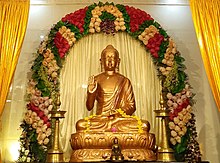
Artistic depictions
Some of the earliest artistic depictions of the Buddha found at Bharhut and Sanchi are aniconic and symbolic. During this early aniconic period, the Buddha is depicted by other objects or symbols, such as an empty throne, a riderless horse, footprints, a Dharma wheel or a Bodhi tree.[401] The art at Sanchi also depicts the Jataka narratives of the Buddha in his past lives.[402]
Other styles of Indian Buddhist art depict the Buddha in human form, either standing, sitting crossed legged (often in the Lotus Pose) or laying down on one side. Iconic representations of the Buddha became particularly popular and widespread after the first century CE.[403] Some of these depictions of the Buddha, particularly those of Gandharan Buddhism and Central Asian Buddhism, were influenced by Hellenistic art, a style known as Greco-Buddhist art.[404]
These various Indian and Central Asian styles would then go on to influence the art of East Asian Buddhist Buddha images, as well as those of Southeast Asian Theravada Buddhism.
Gallery showing different Buddha styles
- A Royal Couple Visits the Buddha, from railing of the Bharhut Stupa, Shunga dynasty, early 2nd century BC.
 Adoration of the Diamond Throne and the Bodhi Tree, Bharhut.
Adoration of the Diamond Throne and the Bodhi Tree, Bharhut.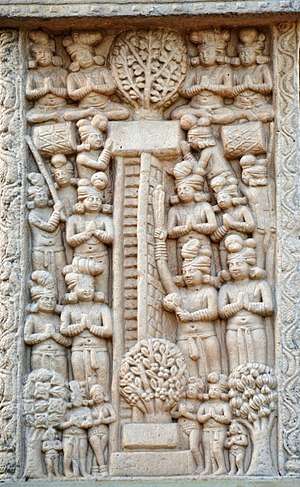 Descent of the Buddha from the Trayastrimsa Heaven, Sanchi Stupa No. 1.
Descent of the Buddha from the Trayastrimsa Heaven, Sanchi Stupa No. 1.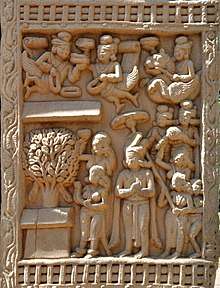 The Buddha's Miracle at Kapilavastu, Sanchi Stupa 1.
The Buddha's Miracle at Kapilavastu, Sanchi Stupa 1._at_Rajagriha%2C_the_visit_of_Bimbisara.jpg) Bimbisara visiting the Buddha (represented as empty throne) at the Bamboo garden in Rajagriha
Bimbisara visiting the Buddha (represented as empty throne) at the Bamboo garden in Rajagriha- The great departure with riderless horse, Amaravati, 2nd century CE.
 The Assault of Mara, Amaravati, 2nd century CE.
The Assault of Mara, Amaravati, 2nd century CE.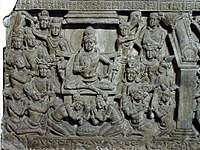 Buddha Preaching in Tushita Heaven. Amaravati, Satavahana period, 2d century CE. Indian Museum, Calcutta.
Buddha Preaching in Tushita Heaven. Amaravati, Satavahana period, 2d century CE. Indian Museum, Calcutta.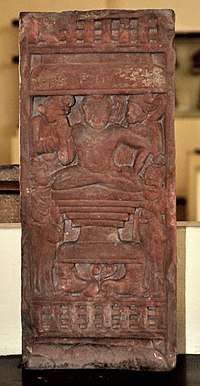 Isapur Buddha, one of the earliest physical depictions of the Buddha, circa 15 CE.[405] Art of Mathura
Isapur Buddha, one of the earliest physical depictions of the Buddha, circa 15 CE.[405] Art of Mathura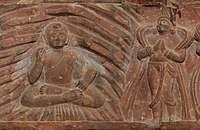 The Buddha attended by Indra at Indrasala Cave, Mathura 50-100 CE.
The Buddha attended by Indra at Indrasala Cave, Mathura 50-100 CE. Buddha Preaching in Tushita Heaven. Amaravati, 2nd century CE.
Buddha Preaching in Tushita Heaven. Amaravati, 2nd century CE..jpeg) Standing Buddha from Gandhara.
Standing Buddha from Gandhara.- Kushan period Buddha Triad.
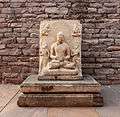 Buddha statue from Sanchi.
Buddha statue from Sanchi.- Birth of the Buddha, Kushan dynasty, late 2nd to early 3rd century CE.
 The Infant Buddha Taking A Bath, Gandhara 2nd century CE.
The Infant Buddha Taking A Bath, Gandhara 2nd century CE. 6th century Gandharan Buddha.
6th century Gandharan Buddha.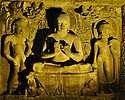 Buddha at Cave No. 6, Ajanta Caves.
Buddha at Cave No. 6, Ajanta Caves.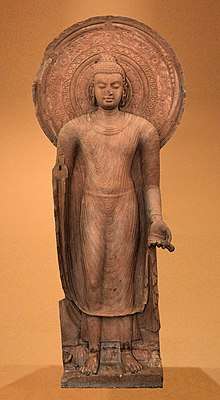 Standing Buddha, Circa 5th Century CE.
Standing Buddha, Circa 5th Century CE. Sarnath standing Buddha, 5th century CE.
Sarnath standing Buddha, 5th century CE.- Seated Buddha, Gupta period.
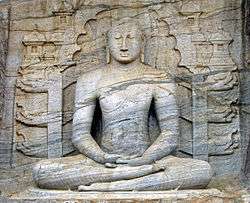 Seated Buddha at Gal Vihara, Sri Lanka.
Seated Buddha at Gal Vihara, Sri Lanka. Chinese Stele with Sakyamuni and Bodhisattvas, Wei period, 536 CE.
Chinese Stele with Sakyamuni and Bodhisattvas, Wei period, 536 CE. The Shakyamuni Daibutsu Bronze, c. 609, Nara, Japan.
The Shakyamuni Daibutsu Bronze, c. 609, Nara, Japan. Amaravati style Buddha of Srivijaya period, Palembang, Indonesia, 7th century.
Amaravati style Buddha of Srivijaya period, Palembang, Indonesia, 7th century.- Korean Seokguram Cave Buddha, c. 774 CE.
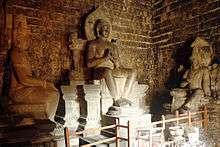 Seated Buddha Vairocana flanked by Avalokiteshvara and Vajrapani of Mendut temple, Central Java, Indonesia, early 9th century.
Seated Buddha Vairocana flanked by Avalokiteshvara and Vajrapani of Mendut temple, Central Java, Indonesia, early 9th century. Buddha in the exposed stupa of Borobudur mandala, Central Java, Indonesia, c. 825.
Buddha in the exposed stupa of Borobudur mandala, Central Java, Indonesia, c. 825..jpg) Vairocana Buddha of Srivijaya style, Southern Thailand, 9th century.
Vairocana Buddha of Srivijaya style, Southern Thailand, 9th century. Attack of Mara, 10th century, Dunhuang.
Attack of Mara, 10th century, Dunhuang..jpg) Cambodian Buddha with Muchilinda Naga, c. 1100 CE, Banteay Chhmar, Cambodia
Cambodian Buddha with Muchilinda Naga, c. 1100 CE, Banteay Chhmar, Cambodia 15th century Sukhothai Buddha.
15th century Sukhothai Buddha. 15th century Sukhothai Walking Buddha.
15th century Sukhothai Walking Buddha.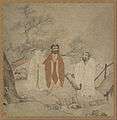 Sakyamuni, Lao Tzu, and Confucius, c. from 1368 until 1644.
Sakyamuni, Lao Tzu, and Confucius, c. from 1368 until 1644..jpg) Chinese depiction of Shakyamuni, 1600.
Chinese depiction of Shakyamuni, 1600.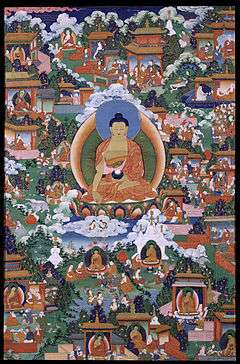 Shakyamuni Buddha with Avadana Legend Scenes, Tibetan, 19th century
Shakyamuni Buddha with Avadana Legend Scenes, Tibetan, 19th century.jpg) Golden Thai Buddha statue, Bodh Gaya.
Golden Thai Buddha statue, Bodh Gaya. Gautama statue, Shanyuan Temple, Liaoning Province, China.
Gautama statue, Shanyuan Temple, Liaoning Province, China.- Burmese style Buddha, Shwedagon pagoda, Yangon.
In other media
- Films
- Little Buddha, a 1994 film by Bernardo Bertolucci
- Prem Sanyas, a 1925 silent film, directed by Franz Osten and Himansu Rai
- Television
- Buddha, a 2013 mythological drama on Zee TV
- The Buddha 2010 PBS documentary by award-winning filmmaker David Grubin and narrated by Richard Gere
- Literature
- The Light of Asia, an 1879 epic poem by Edwin Arnold
- Buddha, a manga series that ran from 1972 to 1983 by Osamu Tezuka
- Siddhartha novel by Hermann Hesse, written in German in 1922
- Lord of Light, a novel by Roger Zelazny depicts a man in a far future Earth Colony who takes on the name and teachings of the Buddha
- Creation, a 1981 novel by Gore Vidal, includes the Buddha as one of the religious figures that the main character encounters
- Music
- Karuna Nadee, a 2010 oratorio by Dinesh Subasinghe
- The Light of Asia, an 1886 oratorio by Dudley Buck
Notes
- According to the Buddhist tradition, following the Nidanakatha,[45] the introductory to the Jataka tales, the stories of the former lives of the Buddha, Gautama was born in Lumbini, present-day Nepal.[46][47] In the mid-3rd century BCE the Emperor Ashoka determined that Lumbini was Gautama's birthplace and thus installed a pillar there with the inscription: "...this is where the Buddha, sage of the Śākyas (Śākyamuni), was born."[48]
Based on stone inscriptions, there is also speculation that Lumbei, Kapileswar village, Odisha, at the east coast of India, was the site of ancient Lumbini.[49][50][51] Hartmann discusses the hypothesis and states, "The inscription has generally been considered spurious (...)"[52] He quotes Sircar: "There can hardly be any doubt that the people responsible for the Kapilesvara inscription copied it from the said facsimile not much earlier than 1928."
Kapilavastu was the place where he grew up:[53][note 7] Gethin does not give references for this statement. - According to Mahaparinibbana Sutta,[4] Gautama died in Kushinagar, which is located in present-day Uttar Pradesh, India.
- /sɪˈdɑːrtə, -θə/; Sanskrit: [sɪddʱaːrtʰɐ ɡautɐmɐ]; Gautama namely Gotama in Pali
-
- 411–400: Dundas 2002, p. 24: "...as is now almost universally accepted by informed Indological scholarship, a re-examination of early Buddhist historical material, [...], necessitates a redating of the Buddha's death to between 411 and 400 BCE..."
- 405: Richard Gombrich[35][33][36][37]
- Around 400: See the consensus in the essays by leading scholars in Narain, Awadh Kishore, ed. (2003). The Date of the Historical Śākyamuni Buddha. New Delhi: BR Publishing. ISBN 8176463531..
- According to Pali scholar K. R. Norman, a life span for the Buddha of c. 480 to 400 BCE (and his teaching period roughly from c. 445 to 400 BCE) "fits the archaeological evidence better".[38] See also Notes on the Dates of the Buddha Íåkyamuni.
- Sanskrit: [ɕaːkjɐmʊnɪ bʊddʱɐ]
- In 2013, archaeologist Robert Coningham found the remains of a Bodhigara, a tree shrine, dated to 550 BCE at the Maya Devi Temple, Lumbini, speculating that it may possibly be a Buddhist shrine. If so, this may push back the Buddha's birth date.[41] Archaeologists caution that the shrine may represent pre-Buddhist tree worship, and that further research is needed.[41]
Richard Gombrich has dismissed Coningham's speculations as "a fantasy", noting that Coningham lacks the necessary expertise on the history of early Buddhism.[42]
Geoffrey Samuel notes that several locations of both early Buddhism and Jainism are closely related to Yaksha-worship, that several Yakshas were "converted" to Buddhism, a well-known example being Vajrapani,[43] and that several Yaksha-shrines, where trees were worshipped, were converted into Buddhist holy places.[44] - Some sources mention Kapilavastu as the birthplace of the Buddha. Gethin states: "The earliest Buddhist sources state that the future Buddha was born Siddhārtha Gautama (Pali Siddhattha Gotama), the son of a local chieftain—a rājan—in Kapilavastu (Pali Kapilavatthu) what is now the Indian–Nepalese border."<ref name='FOOTNOTEGethin199814'>Gethin 1998, p. 14.
- According to Alexander Berzin, "Buddhism developed as a shramana school that accepted rebirth under the force of karma, while rejecting the existence of the type of soul that other schools asserted. In addition, the Buddha accepted as parts of the path to liberation the use of logic and reasoning, as well as ethical behavior, but not to the degree of Jain asceticism. In this way, Buddhism avoided the extremes of the previous four shramana schools."[71]
- Minor Rock Edict Nb3: "These Dhamma texts – Extracts from the Discipline, the Noble Way of Life, the Fears to Come, the Poem on the Silent Sage, the Discourse on the Pure Life, Upatisa's Questions, and the Advice to Rahula which was spoken by the Buddha concerning false speech – these Dhamma texts, reverend sirs, I desire that all the monks and nuns may constantly listen to and remember. Likewise the laymen and laywomen."[79]
Dhammika:"There is disagreement amongst scholars concerning which Pali suttas correspond to some of the text. Vinaya samukose: probably the Atthavasa Vagga, Anguttara Nikaya, 1:98–100. Aliya vasani: either the Ariyavasa Sutta, Anguttara Nikaya, V:29, or the Ariyavamsa Sutta, Anguttara Nikaya, II: 27–28. Anagata bhayani: probably the Anagata Sutta, Anguttara Nikaya, III:100. Muni gatha: Muni Sutta, Sutta Nipata 207–21. Upatisa pasine: Sariputta Sutta, Sutta Nipata 955–75. Laghulavade: Rahulavada Sutta, Majjhima Nikaya, I:421."[79] - Kumar Singh, Nagendra (1997). "Buddha as depicted in the Purāṇas". Encyclopaedia of Hinduism. 7. Anmol Publications. pp. 260–75. ISBN 978-81-7488-168-7. Retrieved 16 April 2012.
- According to Geoffrey Samuel, the Buddha was born into a Kshatriya clan,[120] in a moderate Vedic culture at the central Ganges Plain area, where the shramana-traditions developed. This area had a moderate Vedic culture, where the Kshatriyas were the highest varna, in contrast to the Brahmanic ideology of Kuru–Panchala, where the Brahmins had become the highest varna.[120] Both the Vedic culture and the shramana tradition contributed to the emergence of the so-called "Hindu-synthesis" around the start of the Common Era.[121][120]
- Scholars have noted inconsistencies in the presentations of the Buddha's enlightenment, and the Buddhist path to liberation, in the oldest sutras. These inconsistencies show that the Buddhist teachings evolved, either during the lifetime of the Buddha, or thereafter. See:
* Andre Bareau (1963), Recherches sur la biographie du Buddha dans les Sutrapitaka et les Vinayapitaka anciens, Ecole Francaise d'Extreme-Orient
* Schmithausen, On some Aspects of Descriptions or Theories of 'Liberating Insight' and 'Enlightenment' in Early Buddhism
* K.R. Norman, Four Noble Truths
* Tilman Vetter, The Ideas and Meditative Practices of Early Buddhism
* Richard F. Gombrich (2006). "4". How Buddhism Began: The Conditioned Genesis of the Early Teachings. Routledge. ISBN 978-1-134-19639-5.
* Bronkhorst, Johannes (1993), "7", The Two Traditions Of Meditation In Ancient India, Motilal Banarsidass Publishers
* Anderson, Carol (1999), Pain and Its Ending: The Four Noble Truths in the Theravada Buddhist Canon, Routledge - Waley notes: suukara-kanda, "pig-bulb"; suukara-paadika, "pig's foot" and sukaresh.ta "sought-out by pigs". He cites Neumann's suggestion that if a plant called "sought-out by pigs" exists then suukaramaddava can mean "pig's delight".
- Exemplary studies are the study on descriptions of "liberating insight" by Lambert Schmithausen,[261] the overview of early Buddhism by Tilmann Vetter,[258] the philological work on the four truths by K.R. Norman,[262] the textual studies by Richard Gombrich,[260] and the research on early meditation methods by Johannes Bronkhorst.[257]
- Two well-known proponent of this position are A.K. Warder and Richard Gombrich.
* According to A.K. Warder, in his 1970 publication "Indian Buddhism}, "from the oldest extant texts a common kernel can be drawn out.[264] According to Warder, c.q. his publisher: "This kernel of doctrine is presumably common Buddhism of the period before the great schisms of the fourth and third centuries BC. It may be substantially the Buddhism of the Buddha himself, although this cannot be proved: at any rate it is a Buddhism presupposed by the schools as existing about a hundred years after the parinirvana of the Buddha, and there is no evidence to suggest that it was formulated by anyone else than the Buddha and his immediate followers".[264]
* Richard Gombrich: "I have the greatest difficulty in accepting that the main edifice is not the work of a single genius. By "the main edifice" I mean the collections of the main body of sermons, the four Nikāyas, and of the main body of monastic rules."[260] - A proponent of the second position is Ronald Davidson.
- Ronald Davidson: "While most scholars agree that there was a rough body of sacred literature (disputed)(sic) that a relatively early community (disputed)(sic) maintained and transmitted, we have little confidence that much, if any, of surviving Buddhist scripture is actually the word of the historical Buddha."[265]
- Well-known proponents of the third position are:
* J.W. de Jong: "It would be hypocritical to assert that nothing can be said about the doctrine of earliest Buddhism [...] the basic ideas of Buddhism found in the canonical writings could very well have been proclaimed by him [the Buddha], transmitted and developed by his disciples and, finally, codified in fixed formulas."[266]
* Johannes Bronkhorst: "This position is to be preferred to (ii) for purely methodological reasons: only those who seek may find, even if no success is guaranteed."[263]
* Donald Lopez: "The original teachings of the historical Buddha are extremely difficult, if not impossible, to recover or reconstruct."[267] - aggihuttamukhā yaññā sāvittī chandaso mukham. Sacrifices have the Agnihotra as foremost; of meter, the foremost is the Sāvitrī.[274]
- Understanding of these marks helps in the development of detachment:
- “Not by water man becomes pure; people here bathe too much; in whom there is truth and morality, he is pure, he is (really) a brahman”[281]
- “These three things, monks, are conducted in secret, not openly. What three? Affairs with women, the mantras of the brahmins, and wrong view. But these three things, monks, shine openly, not in secret. What three? The moon, the sun, and the Dhamma and Discipline proclaimed by the Tathagata.” AN 3.129[282]
- "In a favourite stanza quoted several times in the Pali Canon: “The kshatriya is the best among those people who believe in lineage; but he, who is endowed with knowledge and good conduct, is the best among Gods and men”.[281]
- One common basic list of twelve elements in the Early Buddhist Texts goes as follows: "Conditioned by (1) ignorance are (2) formations, conditioned by formations is (3) consciousness, conditioned by consciousness is (4) mind-and-body, conditioned by mind-and-body are (5) the six senses, conditioned by the six senses is (6) sense-contact, conditioned by sense-contact is (7) feeling, conditioned by feeling is (8) craving, conditioned by craving is (9) grasping, conditioned by grasping is (10) becoming, conditioned by becoming is (11) birth, conditioned by birth is (12) old-age and death-grief, lamentation, pain, sorrow, and despair come into being. Thus is the arising of this whole mass of suffering."[306]
- right view; right intention, right speech, right action, right livelihood, right effort, right mindfulness, and right concentration.[338]
- Gethin adds: "This schema is assumed and, in one way or another, adapted by the later manuals such as the Visuddhimagga, the Abhidharmakosa, Kamalasila's Bhavanakrama ('Stages of Meditation', eighth century) and also Chinese and later Tibetan works such as Chih-i's Mo-ho chih-kuan ('Great Calm and Insight') and Hsiu-hsi chih-kuan tso-ch'an fa-yao ('The Essentials for Sitting in Meditation and Cultivating Calm and Insight', sixth century), sGam-po-pa's Thar-pa rin-po che'i rgyan ('Jewel Ornament of Liberation', twelfth century) and Tsong-kha-pa's Lam rim chen mo ('Great Graduated Path', fourteenth century).[343]
- As Gethin notes: "A significant ancient variation on the formula of dependent arising, having detailed the standard sequence of conditions leading to the arising of this whole mass of suffering, thus goes on to state that: Conditioned by (1) suffering, there is (2) faith, conditioned by faith, there is (3) gladness, conditioned by gladness, there is (4) joy, conditioned by joy, there is (5) tranquillity, conditioned by tranquillity, there is (6) happiness, conditioned by happiness, there is (7) concentration, conditioned by concentration, there is (8) knowledge and vision of what truly is, conditioned by knowledge and vision of what truly is, there is (9) disenchantment, conditioned by disenchantment, there is (10) dispassion, conditioned by dispassion, there is (11) freedom, conditioned by freedom, there is (12) knowledge that the defilements are destroyed."[347]
- "thus, from the not giving of property to the needy, poverty became rife, from the growth of poverty, the taking of what was not given increased, from the increase of theft, the use of weapons increased, from the increased use of weapons, the taking of life increased — and from the increase in the taking of life, people’s life-span decreased, their beauty decreased, and [as] a result of this decrease of life-span and beauty, the children of those whose life-span had been eighty-thousand years lived for only forty thousand."[365]
- Vetter: "However, if we look at the last, and in my opinion the most important, component of this list [the noble eightfold path], we are still dealing with what according to me is the real content of the middle way, dhyana-meditation, at least the stages two to four, which are said to be free of contemplation and reflection. Everything preceding the eighth part, i.e. right samadhi, apparently has the function of preparing for the right samadhi."[372]
- "in Sanskrit philosophical literature, 'āstika' means 'one who believes in the authority of the Vedas', 'soul', 'Brahman'. ('nāstika' means the opposite of these).[385][386]
References
- Cousins 1996, pp. 57–63.
- Norman 1997, p. 33.
- Prebish, Carles S."Cooking the Buddhist Books: The Implications of the New Dating of the Buddha for the History of Early Indian Buddhism." Journal of Buddhist Ethics ISSN 1076-9005
- "Maha-parinibbana Sutta", Digha Nikaya, Access insight, part 5
- Gethin (1998), pp. 5, 9, 10, 14.
- Strong, J.S. (2001), p. 1.
- Warder 2000, p. 45.
- Boeree, C George. "An Introduction to Buddhism". Shippensburg University. Retrieved 10 September 2011.
- Strong, J.S. (2001), p. 131.
- Laumakis 2008, p. 4.
- Gethin (1998), p. 8.
- Gethin (1998), pp. 40–41.
- Warder 2000, p. 4-7, 44.
- Warder 2000, p. 4.
- Cox, Collett (2003). "Abidharma", in: Buswell, Robert E. ed. Encyclopedia of Buddhism, New York: Macmillan Reference Lib. pp. 1–7. ISBN 0028657187.
- Baroni 2002, p. 230.
- Chalmers, Robert. The Journal of the Royal Asiatic Society, 1898. pp. 103–115
- Dhammananda, Ven. Dr. K. Sri, Great Virtues of the Buddha (PDF), Dhamma talks
- Roshen Dalal (2014). The Religions of India: A Concise Guide to Nine Major Faiths. Penguin Books. ISBN 9788184753967. Entry: "Jina"
- Snyder, David N. (2006) "The Complete Book of Buddha's Lists--explained." Vipassana Foundation, list 605 p. 429.
- Rawlinson, Hugh George. (1950) A Concise History of the Indian People, Oxford University Press. p. 46.
- Muller, F. Max. (2001) The Dhammapada And Sutta-nipata, Routledge (UK). p. xlvii. ISBN 0-7007-1548-7.
- India: A History. Revised and Updated, by John Keay: "The date [of Buddha's meeting with Bimbisara] (given the Buddhist 'short chronology') must have been around 400 BCE."
- Smith 1924, pp. 34, 48.
- Schumann 2003, pp. 1–5.
- Carrithers 2001, p. 3.
- Buswell 2003, p. 352.
- Lopez 1995, p. 16.
- Wynne, Alexander. "Was the Buddha an awakened prince or a humble itinerant?". Aeon. Retrieved 9 May 2020.
- Schumann 2003, pp. 10–13.
- Bechert 1991–1997.
- Ruegg 1999, pp. 82–87.
- Narain 1993, pp. 187–201.
- Prebish 2008, p. 2.
- Gombrich 1992.
- Hartmann 1991.
- Gombrich 2000.
- Norman 1997, p. 39.
- Schumann 2003, p. xv.
- Wayman 1997, pp. 37–58.
- Vergano, Dan (25 November 2013). "Oldest Buddhist Shrine Uncovered In Nepal May Push Back the Buddha's Birth Date". National Geographic. Retrieved 26 November 2013.
- Gombrich, Richard (2013), Recent discovery of "earliest Buddhist shrine" a sham?, Tricycle
- Tan, Piya (21 December 2009), Ambaṭṭha Sutta. Theme: Religious arrogance versus spiritual openness (PDF), Dharma farer, archived from the original (PDF) on 9 January 2016, retrieved 22 October 2014
- Samuels 2010, pp. 140–52.
- Davids, Rhys, ed. (1878), Buddhist birth-stories; Jataka tales. The commentary introd. entitled Nidanakatha; the story of the lineage. Translated from V. Fausböll's ed. of the Pali text by TW Rhys Davids (new & rev. ed.)
- "Lumbini, the Birthplace of the Lord Buddha". UNESCO. Retrieved 26 May 2011.
- "The Astamahapratiharya: Buddhist pilgrimage sites". Victoria and Albert Museum. Archived from the original on 31 October 2012. Retrieved 25 December 2012.
- Gethin 1998, p. 19.
- Mahāpātra 1977.
- Mohāpātra 2000, p. 114.
- Tripathy 2014.
- Hartmann 1991, pp. 38–39.
- Keown & Prebish 2013, p. 436.
- Walshe 1995, p. 20.
- Nakamura 1980, p. 18.
- Srivastava 1979, pp. 61–74.
- Srivastava 1980, p. 108.
- Tuladhar 2002, pp. 1–7.
- Huntington 1986.
- Gombrich 1988, p. 49.
- Bronkhorst, J. (2007). "Greater Magadha, Studies in the culture of Early India," p. 6. Leiden, Boston, MA: Brill. doi:10.1163/ej.9789004157194.i-416
- Levman, Bryan Geoffrey (2013). "Cultural Remnants of the Indigenous Peoples in the Buddhist Scriptures", Buddhist Studies Review 30 (2), 145-180. ISSN (online) 1747-9681.
- Levman, Bryan Geoffrey. "Cultural Remnants of the Indigenous Peoples in the Buddhist Scriptures." Buddhist Studies Review ISSN (online) 1747-9681.
- Levman, Bryan Geoffrey. "Cultural Remnants of the Indigenous Peoples in the Buddhist Scriptures." Buddhist Studies Review ISSN (online) 1747-9681.
- Levman, Bryan Geoffrey."Cultural Remnants of the Indigenous Peoples in the Buddhist Scriptures." Buddhist Studies Review ISSN (online) 1747-9681.
- Beckwith, Christopher I. (2015). Greek Buddha: Pyrrho's Encounter with Early Buddhism in Central Asia. Princeton University Press. pp. 1–21. ISBN 9781400866328.
- Jayatilleke 1963, chpt. 1–3.
- Clasquin-Johnson, Michel. "Will the real Nigantha Nātaputta please stand up? Reflections on the Buddha and his contemporaries". Journal for the Study of Religion. 28 (1): 100–14. ISSN 1011-7601.
- Walshe 1995, p. 268.
- Collins 2009, pp. 199–200.
- Berzin, Alexander (April 2007). "Indian Society and Thought before and at the Time of Buddha". Study Buddhism. Retrieved 20 June 2016.
- Nakamura 1980, p. 20.
- Wynne 2007, pp. 8–23, ch. 2.
- Warder 1998, p. 45.
- Roy 1984, p. 1.
- Roy 1984, p. 7.
- Beckwith, Christopher I. (2015). Greek Buddha: Pyrrho's Encounter with Early Buddhism in Central Asia. Princeton University Press. pp. 7–12. ISBN 978-1-4008-6632-8.
- In Ashoka's Rummindei Edict circa 260 BCE, in Hultzsch, E. (1925). Inscriptions of Asoka. New Edition by E. Hultzsch (in Sanskrit). p. 164.
- Dhammika 1993.
- Bhikkhu, Thanissaro. "That the True Dhamma Might Last a Long Time: Readings Selected by King Asoka". Access to Insight. Retrieved 8 January 2016.
- Leoshko, Janice (2017). Sacred Traces: British Explorations of Buddhism in South Asia. Routledge. p. 64. ISBN 978-1-351-55030-7.
- "Ancient Buddhist Scrolls from Gandhara". UW Press. Archived from the original on 27 May 2017. Retrieved 4 September 2008.
- Oskar von Hinüber "Hoary past and hazy memory. On the history of early Buddhist texts", in Journal of the International Association of Buddhist Studies, Volume 29, Number 2: 2006 (2008), pp. 198–206
- see also: Michael Witzel, (2009), "Moving Targets? Texts, language, archaeology and history in the Late Vedic and early Buddhist periods." in Indo-Iranian Journal 52(2–3): 287–310.
- Strong, J.S. (2001), p. 5.
- "The earliest anthropomorphic representation of the Buddha that we know so far, the Bimaran reliquary" Yaldiz, Marianne (1987). Investigating Indian Art. Staatl. Museen Preuss. Kulturbesitz. p. 188.
- Verma, Archana (2007). Cultural and Visual Flux at Early Historical Bagh in Central India. Archana Verma. p. 1. ISBN 978-1-4073-0151-8.
- Fowler 2005, p. 32.
- Beal 1883.
- Cowell 1894.
- Willemen 2009.
- Olivelle, Patrick (2008). Life of the Buddha by Ashva-ghosha (1st ed.). New York: New York University Press. p. xix. ISBN 978-0-8147-6216-5.
- Karetzky 2000, p. xxi.
- Beal 1875.
- Swearer 2004, p. 177.
- Schober 2002, p. 20.
- Anålayo, "The Buddha and Omniscience", Indian International Journal of Buddhist Studies, 2006, vol. 7 pp. 1–20.
- Tan, Piya (trans) (2010). "The Discourse to Sandaka (trans. of Sandaka Sutta, Majjhima Nikāya 2, Majjhima Paṇṇāsaka 3, Paribbājaka Vagga 6)" (PDF). The Dharmafarers. The Minding Centre. pp. 17–18. Retrieved 24 September 2015.
- MN 71 Tevijjavacchagotta [Tevijjavaccha]
- Access to Insight, ed. (2005). "A Sketch of the Buddha's Life: Readings from the Pali Canon". Access to Insight: Readings in Theravāda Buddhism. Access to Insight (Legacy Edition). Retrieved 24 September 2015.
- Jones 1956.
- Skilton 2004, pp. 64–65.
- Carrithers 2001, p. 15.
- Armstrong 2000, p. xii.
- Carrithers 2001.
- Strong, J.S. (2001), p. 19.
- Strong, J.S. (2001), p. 21.
- Strong, J.S. (2001), p. 24.
- Strong, J.S. (2001), p. 30.
- Strong, J.S. (2001), p. 31.
- Strong, J.S. (2001), p. 25.
- Strong, J.S. (2001), p. 37.
- Strong, J.S. (2001), p. 43.
- "Lumbini, the Birthplace of the Lord Buddha". World Heritage Convention. United Nations Educational, Scientific and Cultural Organization. Retrieved 1 May 2018.
- Weise 2013.
- Trainor 2010, pp. 436–37.
- Huntington 1988.
- Hirakawa (1990), p. 21.
- Gethin (1998), p. 14.
- Samuel 2010.
- Hiltebeitel 2002.
- Beal 1875, p. 37.
- Jones 1952, p. 11.
- Beal 1875, p. 41.
- Ñāṇamoli Bhikkhu (1992), p. 8.
- Strong, J.S. (2001), p. 51.
- Hirakawa (1990), p. 24.
- Dhammika, Shravasti, 1951- ([199-?]). The Buddha & his disciples. Singapore: Buddha Dhamma Mandala Society. ISBN 981-00-4525-5. OCLC 173196980. Check date values in:
|date=(help)CS1 maint: multiple names: authors list (link) - Gethin (1998), pp. 14–15.
- Gombrich 1988, pp. 49–50.
- Thapar 2002, p. 146.
- Turpie 2001, p. 3.
- Narada 1992, pp. 9–12.
- Strong, J.S. (2001), p. 55.
- Narada 1992, pp. 11–12.
- Hamilton 2000, p. 47.
- Meeks 2016, p. 139.
- Schumann, Hans Wolfgang (2003), p. 23.
- Strong, J.S. (2001), p. 60.
- Gethin (1998), p. 15.
- Analayo (2011). "A Comparative Study of the Majjhima-nikāya Volume 1 (Introduction, Studies of Discourses 1 to 90)," p. 170.
- Wynne, Alexander. Did the Buddha exist? JOCBS. 2019(16): 98–148.
- Schumann, Hans Wolfgang (2003), p. 45.
- Schumann, Hans Wolfgang (2003), pp. 45-46.
- Analayo (2011). "A Comparative Study of the Majjhima-nikāya Volume 1 (Introduction, Studies of Discourses 1 to 90)," p. 173.
- Gethin (1998), p. 21.
- Strong, J.S. (2001), p. 63.
- Gethin (1998), p. 20.
- Conze 1959, pp. 39–40.
- Warder 2000, p. 322.
- Schumann, Hans Wolfgang (2003), p. 44.
- Strong 2001, Incitements to Leave Home.
- Strong 2015, The Beginnings of Discontent.
- Narada 1992, pp. 15–16.
- Strong 2015, The Great Departure.
- Penner 2009, p. 28.
- Strong 2001, The Great Departure.
- Hirakawa 1990, p. 25.
- Upadhyaya 1971, p. 95.
- Laumakis 2008, p. 8.
- Grubin 2010.
- Schumann, Hans Wolfgang (2003), p. 47.
- Analayo (2011). "A Comparative Study of the Majjhima-nikāya Volume 1 (Introduction, Studies of Discourses 1 to 90)," p. 175.
- Schumann, Hans Wolfgang (2003), p. 48.
- Armstrong 2000, p. 77.
- Narada 1992, pp. 19–20.
- Ñāṇamoli Bhikkhu (1992), p. 15.
- Hirakawa (1990), p. 26.
- Analayo (2011). "A Comparative Study of the Majjhima-nikāya Volume 1 (Introduction, Studies of Discourses 1 to 90)," pp. 234–235..
- Analayo (2011). "A Comparative Study of the Majjhima-nikāya Volume 1 (Introduction, Studies of Discourses 1 to 90)," p. 236.
- "Dhammacakkappavattana Sutta: Setting the Wheel of Dhamma in Motion". Access to insight. 12 February 2012. Retrieved 25 December 2012.
- "The Golden Bowl". Buddha net. Retrieved 25 December 2012.
- Analayo (2011). "A Comparative Study of the Majjhima-nikāya Volume 1 (Introduction, Studies of Discourses 1 to 90)," p. 178.
- Gyatso 2007, pp. 8–9.
- Analayo (2011). "A Comparative Study of the Majjhima-nikāya Volume 1 (Introduction, Studies of Discourses 1 to 90)," p. 240.
- Analayo (2011). "A Comparative Study of the Majjhima-nikāya Volume 1 (Introduction, Studies of Discourses 1 to 90)," p. 243.
- Marshall p. 65
- "nirvana". Encyclopædia Britannica. Retrieved 22 October 2014.
- Thanissaro Bhikkhu (trans.) (1998). Maha-Saccaka Sutta: The Longer Discourse to Saccaka (excerpt) (MN 36). Retrieved 2007-05-19 from:
- Anderson 1999.
- Williams 2002, pp. 74–75.
- Donald Lopez, Four Noble Truths, Encyclopædia Britannica.
- Ñāṇamoli Bhikkhu (1992), p. 30.
- Ñāṇamoli Bhikkhu (1992), pp. 30–35
- Strong, J.S. (2001), p. 93.
- Strong, J.S. (2001), p. 94.
- Analayo (2011). "A Comparative Study of the Majjhima-nikāya Volume 1 (Introduction, Studies of Discourses 1 to 90)," p. 182.
- Analayo (2011). "A Comparative Study of the Majjhima-nikāya Volume 1 (Introduction, Studies of Discourses 1 to 90)," p. 183.
- Boisselier, Jean, (1994). The wisdom of the Buddha. New York: Harry N. Abrams. ISBN 0-8109-2807-8. OCLC 31489012.CS1 maint: extra punctuation (link) CS1 maint: multiple names: authors list (link)
- Analayo (2011). "A Comparative Study of the Majjhima-nikāya Volume 1 (Introduction, Studies of Discourses 1 to 90)," p. 185.
- Ñāṇamoli Bhikkhu (1992), pp. 44–45.
- Strong, J.S. (2001), p. 110.
- Strong, J.S. (2001), p. 113.
- Ñāṇamoli Bhikkhu (1992), pp. 48, 54–59.
- Strong, J.S. (2001), pp. 116–117.
- Ñāṇamoli Bhikkhu (1992), p. 64.
- Strong, J.S. (2001), p. 115.
- Malalasekera 1960, pp. 291–92.
- Schumann, Hans Wolfgang (2003), p. 231.
- Strong, J.S. (2001), p. 132.
- Bhikkhu Khantipalo (1995). "Lay Buddhist Practice, The Shrine Room, Uposatha Day, Rains Residence"
- Ñāṇamoli Bhikkhu (1992), p. 68.
- Ñāṇamoli Bhikkhu (1992), p. 70.
- Strong, J.S. (2001), p. 119.
- Ñāṇamoli Bhikkhu (1992), p. 78.
- Ñāṇamoli Bhikkhu (1992), pp. 79–83.
- Strong, J.S. (2001), p. 122.
- Ñāṇamoli Bhikkhu (1992), p. 91.
- Strong, J.S. (2001), p. 136.
- Analayo (2016), pp. 40–41. Analayo draws from seven early sources: "the Dharmaguptaka Vinaya in Four Parts, preserved in Chinese; – a *Vinayamātṛkā preserved in Chinese translation, which some scholars suggest represents the Haimavata tradition; the Mahāsāṃghika-Lokottaravāda Vinaya, preserved in Sanskrit; – the Mahīśāsaka Vinaya in Five Parts, preserved in Chinese; – the Mūlasarvāstivāda Vinaya, where the episode is extant in Chinese and Tibetan translation, with considerable parts also preserved in Sanskrit fragments; – a discourse in the Madhyama-āgama, preserved in Chinese, probably representing the Sarvāstivāda tradition; a Pāli discourse found among the Eights of the Aṅguttara-nikāya; the same account is also found in the Theravāda Vinaya preserved in Pāli."
- Analayo (2016). "The Foundation History of the Nun's Order," projekt verlag, Bochum/Freiburg, p. 43.
- Analayo (2016). "The Foundation History of the Nun's Order," projekt verlag, Bochum/Freiburg, p. 79.
- Analayo, Bhikkhu (2013). "The Gurudharmaon Bhikṣuṇī Ordination in the Mūlasarvāstivāda Tradition" (PDF). Journal of Buddhist Ethics. 20: 752. ISSN 1076-9005. Retrieved August 17, 2019.
- Analayo (2016). "The Foundation History of the Nun's Order," projekt verlag, Bochum/Freiburg, pp. 111-112.
- Analayo (2016). "The Foundation History of the Nun's Order," projekt verlag, Bochum/Freiburg, p. 127.
- Marshall p. 59
- Strong, J.S. (2001), p. 134.
- Schumann 2003, pp. 232–33.
- Jain, Kailash Chand (1991), Lord Mahāvīra and His Times, p. 79, Motilal Banarsidass, ISBN 978-81-208-0805-8
- Mahajan V.D. (2016), "Ancient India", S. Chand Publishing, p. 190.
- Schumann 2003, p. 215.
- Schumann 2003, p. 232.
- Analayo (2011). "A Comparative Study of the Majjhima-nikāya Volume 1 (Introduction, Studies of Discourses 1 to 90)," p. 198.
- Ñāṇamoli Bhikkhu (1992), p. 257.
- Schumann 2003, p. 236.
- Schumann 2003, p. 237.
- Bhikkhu Sujato (2012), "Why Devadatta Was No Saint, A critique of Reginald Ray’s thesis of the ‘condemned saint’"
- Ñāṇamoli Bhikkhu (1992), p. 280.
- Schumann 2003, p. 239.
- Strong, J.S. (2001), p. 165.
- Analayo (2014). "The Buddha’s Last Meditation in the Dirgha-Agama." The Indian International Journal of Buddhist Studies 15.
- Ñāṇamoli Bhikkhu (1992), pp. 286–88.
- Strong, J.S. (2001), pp. 165–166.
- Schumann 2003, p. 244.
- Schumann 2003, p. 246.
- "Maha-parinibbana Sutta", Digha Nikaya, Access insight, verse 56
- Mettanando & Hinueber 2000.
- Mettanando (15 May 2001). "Buddha net". Archived from the original on 14 November 2012. Retrieved 25 December 2012.
- Waley 1932, pp. 343–54.
- Strong, J.S. (2001), p. 176.
- Schumann 2003, p. 249.
- Strong, J.S. (2001), p. 178.
- Schumann 2003, p. 250.
- Wynne, Alexander (2007), p. 112.
- Strong, J.S. (2001), p. 183.
- Ñāṇamoli Bhikkhu (1992), p. 324.
- Ñāṇamoli Bhikkhu (1992), p. 327.
- Ñāṇamoli Bhikkhu (1992), p. 330.
- Ñāṇamoli Bhikkhu (1992), p. 331.
- Lopez Jr., Donald S. "The Buddha's relics". Encyclopædia Britannica.
- Strong 2007, pp. 136–37.
- Harvey, Peter (2013), An Introduction to Buddhism: Teachings, History and Practices (PDF) (2nd ed.), New York: Cambridge University Press, p. 88, ISBN 978-0-521-85942-4
- Vetter 1988, p. ix.
- Warder 1999.
- Tse-Fu Kuan. Mindfulness in similes in Early Buddhist literature in Edo Shonin, William Van Gordon, Nirbhay N. Singh. Buddhist Foundations of Mindfulness, p. 267.
- Mun-Keat Choong (1999). The Notion of Emptiness in Early Buddhism, Motilal Banarsidass, p. 3.
- Bronkhorst 1993.
- Vetter 1988.
- Schmithausen 1990.
- Gombrich 1997.
- Schmithausen 1981.
- Norman 1992.
- Bronkhorst 1993, p. vii.
- Warder 1999, p. inside flap.
- Davidson 2003, p. 147.
- Jong 1993, p. 25.
- Lopez 1995, p. 4.
- Warder, A.K. (2004). Indian Buddhism, 3rd Revised edition. Motilal Banarsidass.
- Gombrich, Richard F. (1997). How Buddhism Began. Munshiram Manoharlal.
- Gombrich, Richard (2009), "What the Buddha Thought", pp. 9, 36.
- Gombrich, Richard (2009), "What the Buddha Thought", p. 48.
- Wynne, Alexander, The Origin of Buddhist Meditation, pp. 23, 37, Routledge, 2004.
- Levman, Bryan Geoffrey. "Cultural Remnants of the Indigenous Peoples in the Buddhist Scriptures." Buddhist Studies Review ISSN (online) 1747-9681.
- Shults 2014, p. 119.
- Norman 1997, p. 26.
- Bronkhorst, Johannes, The two traditions of meditation in Ancient India, Second edition: Delhi: Motilal Banarsidass. 1993. (Reprint: 2000), p. 10.
- Norman 1997, p. 28.
- Reat, Noble Ross. “The Historical Buddha and his Teachings”. In: Encyclopedia of Indian Philosophy. Ed. by Potter, Karl H. Vol. VII: Abhidharma Buddhism to 150 AD. Motilal Banarsidass, 1996, pp. 28, 33, 37, 41, 43, 48.
- Analayo (2011). A Comparative Study of the Majjhima-nikāya. Dharma Drum Academic Publisher. p. 891.
- Salomon, Richard (20 January 2020). "How the Gandharan Manuscripts Change Buddhist History". lionsroar.com. Retrieved 21 January 2020.
- Tola, Fernando. Dragonetti, Carmen (2009). "Brahamanism and Buddhism: Two Antithetic Conceptions of Society in Ancient India." p. 26: "This also implied the denial of the Shruti provided with characteristics which grant it the status of a substance. All this carried with itself also the negation of the authority of all the sacred texts of Brahmanism. Buddhism does not acknowledge to them any value as ultimate criterion of truth, as depository of the norms which regulate man’s conduct as a member of society and in his relations with the Gods. Buddhism ignores the Shruti, the very foundation of Brahmanism."
- Bodhi (2005), pp. 33–34
- Kancha Ilaiah, "God as Political Philosopher: Buddha's Challenge to Brahminism" p. 162
- Omvedt, Gail. "Buddhism in India: Challenging Brahmanism and Caste" p. 76.
- Omvedt, Gail. "Buddhism in India: Challenging Brahmanism and Caste." p. 72.
- Omvedt, Gail, Review: The Buddha as a Political Philosopher, Vol. 36, No. 21 (May 26 – Jun. 1, 2001), pp. 1801–1804 (4 pages)
- Mrozik, Susanne. "Upali" in MacMillan Encyclopedia of Buddhism, pg. 870.
- Kancha Ilaiah, "God as Political Philosopher: Buddha's Challenge to Brahminism" p. 169
- Gethin (1998), p. 59
- Siderits (2019)
- Gethin (1998), p. 61.
- Gethin (1998), p. 62.
- Gethin (1998), pp. 63–64.
- Anālayo, "The Chinese Parallels to the Dhammacakkappavattana-sutta (2)." Journal of the Oxford Centre for Buddhist Studies, 2013 (5): 9-41.
- Gethin (1998), pp. 72–73.
- Gethin (1998), p. 75.
- Bodhi (2005), pp. 32-33.
- Gombrich (2009), p. 12.
- Bodhi (2005), p. 39.
- Gombrich (2009), p. 49.
- Gombrich (2009), p. 13.
- Gombrich (2009), p. 19.
- Gombrich (2009), p. 20.
- Hamilton (2000) p. 22.
- Gombrich (2009), p. 131.
- Gethin (1998), pp. 141–142.
- Hamilton (2000) p. 20.
- Gombrich (2009), pp. 62–64.
- Hamilton (2000) pp. 23–25.
- Gethin (1998), pp. 134–135.
- Gombrich (2009), pp. 9, 67.
- Gombrich (2009), p. 10.
- Gombrich (2009), pp. 73–74.
- Gethin (1998), p. 135.
- Gombrich (2009), p. 114.
- Hamilton (2000) pp. 19–20.
- Andrew Glass, Mark Allon (2007). "Four Gandhari Samyuktagama Sutras", pp. 5, 15.
- Mun-keat Choong (2000), "The Fundamental Teachings of Early Buddhism: A Comparative Study Based on the Sutranga Portion of the Pali Samyutta-Nikaya and the Chinese Samyuktagama", Otto Harrassowitz Verlag, p. 59.
- Gethin (1998), pp. 136-137.
- Gombrich (2009), pp. 119-120.
- Gombrich (2009), pp. 124-125.
- Gethin (1998), p. 139.
- Gethin (1998), pp. 146-147.
- Gethin (1998), p. 148.
- Hamilton (2000) p. 27.
- Bodhi (2005), pp. 107–109.
- Bodhi (2005), p. 109.
- Pannasiri, Bhadanta (1950). "Sigālovāda-Sutta", Visva-Bharati Annals, 3: 150–228.
- Martini, Giuliana (2013). "Bodhisattva Texts, Ideologies and Rituals in Khotan in the Fifth and Sixth Centuries", in Buddhism among the Iranian Peoples of Central Asia, M. De Chiara et al. (ed.), 11–67, Wien: Österreichische Akademie der Wissenschaften.
- Bodhi (2005), p. 124
- Bodhi (2005), p. 110
- Bodhi (2005), pp. 111, 125.
- Bodhi (2005), pp. 146–148, 156.
- Analayo (2011). "A Comparative Study of the Majjhima-nikāya Volume 1 (Introduction, Studies of Discourses 1 to 90)," p. 263.
- Bodhi (2005), pp. 151, 167.
- Bodhi (2005), p. 229.
- Gethin (1998), p. 81.
- Gethin (1998), p. 164.
- Bucknell, Rod, "The Buddhist Path to Liberation: An Analysis of the Listing of Stages", The Journal of the International Association of Buddhist Studies Volume 7, Number 2, 1984
- Gethin (1998), pp. 217–218.
- Bucknell, Rod, "The Buddhist Path to Liberation: An Analysis of the Listing of Stages", The Journal of the International Association of Buddhist Studies Volume 7, Number 2, 1984.
- Gethin (1998), pp. 83, 165.
- Gethin (1998), p. 165.
- Analayo (2011). "A Comparative Study of the Majjhima-nikāya Volume 1 (Introduction, Studies of Discourses 1 to 90)," p. 189.
- Anālayo. "Brahmavihāra and Awakening, A Study of the Dīrgha-āgama Parallel to the Tevijja-sutta." Asian Literature and Translation Vol. 3, No. 4 (2015) 1– 27 1
- Bodhi, Bhikkhu (1995). "Transcendental Dependent Arising. A Translation and Exposition of the Upanisa Sutta."
- Gethin (1998), p. 157.
- Bodhi (2005), p. 195
- Bodhi (2005), p. 199
- Bodhi (2005), p. 200
- Bodhi (2005), p. 204.
- Bodhi (2005), p. 205.
- Vetter 1988a, pp. xxx, xxxv–xxxvi, 4–5.
- Vetter 1988, p. 5.
- Analayo (2017). "Early Buddhist meditation studies," pp. 80, 128, 135.
- For a comparative survey of Satipatthana in the Pali, Tibetan and Chinese sources, see: Analayo (2014), "Perspectives on Satipatthana." For a comparative survey of Anapanasati, see: Dhammajoti KL (2008), "Sixteen-mode Mindfulness of Breathing", JCBSSL v. VI.
- Gethin (1998), p. 66.
- Gethin (1998), pp. 85, 88.
- Kalupahana (1992) p. 28.
- Gethin (1998), p. 85
- Heirman, Ann (2019). "Vinaya rules for monks and nuns."
- Gethin (1998), p. 87
- Matthew J. Moore, Buddhism and Political Theory, Oxford University Press, 2016 ISBN 9780190465513 p.2
- Moore, Matthew J. (2015)."Political theory in Canonical Buddhism." Philosophy East & West 65 (1), 36–64
- Moore, Matthew J. "Political theory in Canonical Buddhism." Philosophy East & West Volume 65, Number 1 January 2015 36–64
- Gombrich, Richard (2006). "Theravāda Buddhism: A Social History from Ancient Benares to Modern Colombo," p. 21. The Library of Religious Beliefs and Practices Series. Routledge & Kegan Paul.
- Harvey, Peter (1990). "An Introduction to Buddhism: Teachings, History and Practices," p. 3. Introduction to Religion. Cambridge University Press.
- Warder, A.K (2000). "Indian Buddhism," inside flap. Buddhism Series. Motilal Banarsidass.
- Wynne, Alexander (2005). "The Historical Authenticity of Early Buddhist Literature". Vienna Journal of South Asian Studies. XLIX: 35–70.
- Conze, Edward (2000). "Buddhism: A Short History." From Buddhism to Sufism Series. Oneworld.
- Vetter 1988b, p. xxx, xxxv–xxxvi, 4–5.
- Vetter 1988, p. xxx.
- Vetter 1988, p. xxxiv–xxxvii.
- Bronkhorst 1993, p. 107.
- Olivelle, Patrick (1974), "The Origin and the Early Development of Buddhist Monachism", p. 19.
- Mazard, Eisel (2010). "The Buddha was bald," New Mandala.
- S. Dhammika, "The Buddha and his disciples." pp. 23–24.
- Analayo (2017), "Buddhapada and the Bodhisattva Path", pp. 137–138.
- Walshe 1995, pp. 441–60.
- Gopal 1990, p. 73.
- Doniger 1993, p. 243.
- "Buddha". Stanford Encyclopedia of Philosophy. Retrieved 13 July 2015.
- Sushil Mittal & Gene Thursby (2004), The Hindu World, Routledge, ISBN 978-0-415-77227-3, pp. 729–30
- C. Sharma (2013), A Critical Survey of Indian Philosophy, Motilal Banarsidass, ISBN 978-81-208-0365-7, p. 66
- Andrew J. Nicholson (2013), Unifying Hinduism: Philosophy and Identity in Indian Intellectual History, Columbia University Press, ISBN 978-0-231-14987-7, Chapter 9
- GS Ghurye, Indian Sociology Through Ghurye, a Dictionary, Ed. S. Devadas Pillai (2011), ISBN 978-81-7154-807-1, p. 354
- "Book One, Part V – The Buddha and His Predecessors".
- Tribe, Paul Williams with Anthony (2000). Buddhist thought a complete introduction to the Indian tradition. London: Taylor & Francis e-Library. pp. 1–10. ISBN 0-203-18593-5.
- Flood 1996, pp. 231–32.
- "info-sikh.com". www.info-sikh.com.
- Ahmad Faizuddin Ramli1, Jaffary Awang, and Zaizul Ab Rahman Muslim scholar’s discourse on Buddhism: a literature on Buddha’s position SHS Web of Conferences 53, 04001 (2018) https://doi.org/10.1051/shsconf/20185304001 pp. 6–7
- Valentine, Simon Ross (2008), Islam and the Ahmadiyya Jamaʻat: History, Belief, Practice, p. 26, ISBN 9780231700948, retrieved 15 November 2013 – via Google books
- Ousman Kobo (2012). Unveiling Modernity in Twentieth-Century West African Islamic Reforms. Brill Academic. p. 93. ISBN 978-90-04-23313-3.
- Donald Eugene Smith (2015). South Asian Politics and Religion. Princeton University Press. pp. 403–04. ISBN 978-1-4008-7908-3.
- Twitchett 1986.
- Janet 2012, p. 3.
- Janet 2012, p. 9.
- Macdonnel 1900.
- Mershman 1913.
- Barnstone W & Meyer M (2009). The Gnostic Bible: Gnostic texts of mystical wisdom from the ancient and medieval worlds. Shambhala Publications: Boston & London.
- Leidy, Denise Patty (2008). "The Art of Buddhism: An Introduction to Its History & Meaning", Shambhala Publications, p.15.
- Leidy, Denise Patty (2008). "The Art of Buddhism: An Introduction to Its History & Meaning", Shambhala Publications, p. 19.
- Leidy, Denise Patty (2008). "The Art of Buddhism: An Introduction to Its History & Meaning", Shambhala Publications, p. 31.
- Sir John Hubert Marshall (1960). "The Buddhist art of Gandhāra: the story of the early school, its birth, growth and decline"
- Quintanilla, Sonya Rhie (2007). History of Early Stone Sculpture at Mathura: Ca. 150 BCE - 100 CE. BRILL. pp. 199–206, 204 for the exact date. ISBN 9789004155374.
Sources
- Anderson, Carol (1999), Pain and Its Ending: The Four Noble Truths in the Theravada Buddhist Canon, Routledge
- Armstrong, Karen (2000), Buddha, Orion, ISBN 978-0-7538-1340-9
- Asvaghosa (1883), The Fo-sho-hing-tsan-king, a life of Buddha, translated by Beal, Samuel, Oxford: Clarendon
- Bareau, André (1975), "Les récits canoniques des funérailles du Buddha et leurs anomalies: nouvel essai d'interprétation" [The canonical accounts of the Buddha's funerals and their anomalies: new interpretative essay], Bulletin de l'École Française d'Extrême-Orient (in French), Persée, LXII: 151–89, doi:10.3406/befeo.1975.3845
- ——— (1979), "La composition et les étapes de la formation progressive du Mahaparinirvanasutra ancien" [The composition and the etapes of the progressive formation of the ancient Mahaparinirvanasutra], Bulletin de l'École Française d'Extrême-Orient (in French), Persée, LXII: 45–103, doi:10.3406/befeo.1979.4010
- Baroni, Helen J. (2002), The Illustrated Encyclopedia of Zen Buddhism, Rosen
- The romantic legend of Sâkya Buddha (Abhiniṣkramaṇa Sūtra), translated by Beal, Samuel, London: Trübner, 1875
- Bechert, Heinz, ed. (1991–1997), The dating of the historical Buddha (Symposium), vol. 1–3, Göttingen: Vandenhoeck & Ruprecht
- Bodhi, Bhikkhu (2005), In the Buddha's Words: An Anthology of Discourses from the Pali Canon, Simon and Schuster
- Bronkhorst, Johannes (1993), The Two Traditions of Meditation In Ancient India, Motilal Banarsidass
- Buswell, Robert E, ed. (2003), Encyclopedia of Buddhism, 1, US: Macmillan Reference, ISBN 978-0-02-865910-7
- Carrithers, M. (2001), The Buddha: A Very Short Introduction, Oxford University Press, ISBN 978-0-02-865910-7
- Collins, Randall (2009), The Sociology of Philosophies, Harvard University Press, ISBN 978-0-674-02977-4, 1120 pp.
- Conze, Edward, trans. (1959), Buddhist Scriptures, London: Penguin
- Cousins, LS (1996), "The dating of the historical Buddha: a review article", Journal of the Royal Asiatic Society, 3, Indology, 6 (1): 57–63, doi:10.1017/s1356186300014760
- Cowell, Edward Byles, transl. (1894), "The Buddha-Karita of Ashvaghosa", in Müller, Max (ed.), Sacred Books of the East, XLIX, Oxford: Clarendon
- Davidson, Ronald M. (2003), Indian Esoteric Buddhism, Columbia University Press, ISBN 978-0-231-12618-2
- Dhammika, S. (1993), The Edicts of King Asoka: An English Rendering, The Wheel Publication, Kandy, Sri Lanka: Buddhist Publication Society, ISBN 978-955-24-0104-6, archived from the original on 28 October 2013
- Doniger, Wendy, ed. (1993), Purana Perennis: Reciprocity and Transformation in Hindu and Jaina Texts, State University of New York Press, ISBN 0-7914-1381-0
- Dundas, Paul (2002), The Jains (Google Books) (2nd ed.), Routledge, p. 24, ISBN 978-0-415-26606-2, retrieved 25 December 2012
- Eade, JC (1995), The Calendrical Systems of Mainland South-East Asia (illustrated ed.), Brill, ISBN 978-90-04-10437-2
- Epstein, Ronald (2003), Buddhist Text Translation Society's Buddhism A to Z (illustrated ed.), Burlingame, CA: Buddhist Text Translation Society
- Fowler, Mark (2005), Zen Buddhism: beliefs and practices, Sussex Academic Press
- Gethin, Rupert, ML (1998), Foundations of Buddhism, Oxford University Press
- Gombrich, Richard F (1988), Theravada Buddhism: A Social History from Ancient Benares to Modern Colombo, Routledge and Kegan Paul
- ——— (1992), "Dating the Buddha: a red herring revealed", in Bechert, Heinz (ed.), Die Datierung des historischen Buddha [The Dating of the Historical Buddha], Symposien zur Buddhismusforschung (in German), IV, Gottingen: Vandenhoeck and Ruprecht, pp. 237–59.
- ——— (1997), How Buddhism Began, Munshiram Manoharlal
- ——— (2000), "Discovering the Buddha's date", in Perera, Lakshman S (ed.), Buddhism for the New Millennium, London: World Buddhist Foundation, pp. 9–25.
- ——— (2009), What the Buddha thought, Equinox
- Gopal, Madan (1990), K.S. Gautam (ed.), India through the ages, Publication Division, Ministry of Information and Broadcasting, Government of India, p. 73
- Grubin, David (Director), Gere, Richard (Narrator) (2010), The Buddha: The Story of Siddhartha (DVD), David Grubin Productions, 27:25 minutes in, ASIN B0033XUHAO
- Gyatso, Geshe Kelsang (2007), Introduction to Buddhism An Explanation of the Buddhist Way of Life, Tharpa, ISBN 978-0-9789067-7-1
- Hamilton, Sue (2000), Early Buddhism: A New Approach: The I of the Beholder, Routledge
- Hartmann, Jens Uwe (1991), "Research on the date of the Buddha", in Bechert, Heinz (ed.), The Dating of the Historical Buddha (PDF), 1, Göttingen: Vandenhoeck and Ruprecht, pp. 38–39, archived from the original (PDF) on 29 October 2014
- Hiltebeitel, Alf (2002), "Hinduism", in Kitagawa, Joseph (ed.), The Religious Traditions of Asia: Religion, History, and Culture, Routledge, ISBN 9781136875977
- Hirakawa, Akira (1990), A History of Indian Buddhism: From Śākyamuni to Early Mahāyāna, University of Hawaii Press, ISBN 0-8248-1203-4
- Huntington, John C (1986), "Sowing the Seeds of the Lotus" (PDF), Orientations, September 1986: 46–58, archived from the original (PDF) on 28 November 2014
- Jain, Kailash Chand (1991), Lord Mahāvīra and His Times, Motilal Banarsidass, ISBN 978-81-208-0805-8
- Jayatilleke, K.N. (1963), Early Buddhist Theory of Knowledge (1st ed.), London: George Allen & Unwin Ltd.
- Jones, JJ (1949), The Mahāvastu, Sacred Books of the Buddhists, 1, London: Luzac & Co.
- ——— (1952), The Mahāvastu, Sacred Books of the Buddhists, 2, London: Luzac & Co.
- ——— (1956), The Mahāvastu, Sacred Books of the Buddhists, 3, London: Luzac & Co.
- Jong, JW de (1993), "The Beginnings of Buddhism", The Eastern Buddhist, 26 (2)
- Kala, U (2006) [1724], Maha Yazawin Gyi (in Burmese), 1 (4th ed.), Yangon: Ya-Pyei, p. 39
- Kalupahana, David (1992), A History of Buddhist Philosophy: Continuities and Discontinuities, University of Hawaii Press
- Karetzky, Patricia (2000), Early Buddhist Narrative Art, Lanham, MD: University Press of America
- Katz, Nathan (1982), Buddhist Images of Human Perfection: The Arahant of the Sutta Piṭaka, Delhi: Motilal Banarsidass
- Keown, Damien; Prebish, Charles S (2013), Encyclopedia of Buddhism, Routledge
- Lamotte, Etienne (1988), History of Indian Buddhism: From the Origins to the Saka Era, Université catholique de Louvain, Institut orientaliste
- Laumakis, Stephen (2008), An Introduction to Buddhist philosophy, Cambridge; New York: Cambridge University Press, ISBN 978-0-521-85413-9
- Lopez, Donald S (1995), Buddhism in Practice, Princeton University Press, ISBN 978-0-691-04442-2
- Malalasekera, G.P. (1960), Dictionary of Pali Proper Names, Vol. 1, London: Pali Text Society/Luzac, ISBN 9788120618237
- Macdonnel, Arthur Anthony (1900), "

- Mahāpātra, Cakradhara (1977), The real birth place of Buddha, Grantha Mandir
- Meeks, Lori (27 June 2016), "Imagining Rāhula in Medieval Japan" (PDF), Japanese Journal of Religious Studies, 43 (1): 131–51, doi:10.18874/jjrs.43.1.2016.131-151
- Mohāpātra, Gopinath (2000), "Two Birth Plates of Buddha" (PDF), Indologica Taurinensia, 26: 113–19, archived from the original (PDF) on 4 October 2012
- Mershman, Francis (1913), "Barlaam and Josaphat", in Herberman, Charles G; et al. (eds.), The Catholic Encyclopedia, 2, New York: Robert Appleton
- Mettanando, Bhikkhu; Hinueber, Oskar von (2000), "The Cause of the Buddha's Death" (PDF), Journal of the Pali Text Society, XXVI: 105–18, archived from the original (PDF) on 9 April 2015
- Nakamura, Hajime (1980), Indian Buddhism: a survey with bibliographical notes, Motilal Banarsidass, ISBN 978-81-208-0272-8
- Narada (1992), A Manual of Buddhism, Buddha Educational Foundation, ISBN 978-967-9920-58-1
- Narain, A.K. (1993), "Book Review: Heinz Bechert (ed.), The dating of the Historical Buddha, part I", Journal of the International Association of Buddhist Studies, 16 (1): 187–201
- Norman, KR (1997), A Philological Approach to Buddhism, The Bukkyo Dendo Kyokai Lectures 1994, School of Oriental and African Studies (University of London)
- Norman, K.R. (2003), "The Four Noble Truths", K.R. Norman Collected Papers II
- Ñāṇamoli, Bhikkhu (1992), The Life of the Buddha: According to the Pali Canon, Buddhist Publication Society
- Penner, Hans H. (2009), Rediscovering the Buddha: The Legends and Their Interpretations, Oxford University Press, ISBN 978-0-19-538582-3
- Prebish, Charles S. (2008), "Cooking the Buddhist Books: The Implications of the New Dating of the Buddha for the History of Early Indian Buddhism" (PDF), Journal of Buddhist Ethics, 15: 1–21, archived from the original (PDF) on 28 January 2012
- Rockhill, William Woodville, transl. (1884), The life of the Buddha and the early history of his order, derived from Tibetan works in the Bkah-Hgyur and Bstan-Hgyur, followed by notices on the early history of Tibet and Khoten, London: Trübner
- Roy, Ashim Kumar (1984), A history of the Jains, New Delhi: Gitanjali, p. 179, CiteSeerX 10.1.1.132.6107
- Ruegg, Seyford (1999), "A new publication on the date and historiography of Buddha´s decease (nirvana): a review article", Bulletin of the School of Oriental and African Studies, University of London, 62 (1): 82–87, doi:10.1017/s0041977x00017572
- Samuel, Geoffrey (2010), The Origins of Yoga and Tantra. Indic Religions to the Thirteenth Century, Cambridge University Press
- Schmithausen, Lambert (1981), "On some Aspects of Descriptions or Theories of 'Liberating Insight' and 'Enlightenment' in Early Buddhism", in von Klaus, Bruhn; Wezler, Albrecht (eds.), Studien zum Jainismus und Buddhismus (Gedenkschrift für Ludwig Alsdorf) [Studies on Jainism and Buddhism (Schriftfest for Ludwig Alsdorf)] (in German), Wiesbaden, pp. 199–250
- Schober, Juliane (2002), Sacred biography in the Buddhist traditions of South and Southeast Asia, Delhi: Motilal Banarsidass
- Schumann, Hans Wolfgang (2003), The Historical Buddha: The Times, Life, and Teachings of the Founder of Buddhism, Motilal Banarsidass, ISBN 978-81-208-1817-0
- Shimoda, Masahiro (2002), "How has the Lotus Sutra Created Social Movements: The Relationship of the Lotus Sutra to the Mahāparinirvāṇa-sūtra", in Reeves, Gene (ed.), A Buddhist Kaleidoscope, Kosei
- Shults, Brett (2014), "On the Buddha's Use of Some Brahmanical Motifs in Pali Texts", Journal of the Oxford Centre for Buddhist Studies, 6: 106–40
- Siderits, Mark (2019), "Buddha", "Buddha", The Stanford Encyclopedia of Philosophy, Metaphysics Research Lab, Stanford University
- Singh, Upinder (2016), A History of Ancient and Early Medieval India: From the Stone Age to the 12th Century, Pearson, ISBN 978-81-317-1677-9
- Srivastava, K.M. (1980), "Archaeological Excavations at Priprahwa and Ganwaria and the Identification of Kapilavastu", Journal of the International Association of Buddhist Studies, 3 (1): 103–10
- Srivastava, K.M. (1979), "Kapilavastu and Its Precise Location", East and West, 29 (1/4): 61–74
- Skilton, Andrew (2004), A Concise History of Buddhism
- Smith, Peter (2000), "Manifestations of God", A concise encyclopaedia of the Bahá'í Faith, Oxford: Oneworld Publications, ISBN 978-1-85168-184-6, 231 pp.
- Smith, Vincent (1924), The Early History of India (4th ed.), Oxford: Clarendon
- Strong, J.S. (2001), The Buddha: A Beginner's Guide, Oneworld Publications, ISBN 978-1-78074-054-6
- Strong, John S (2007), Relics of the Buddha, Motilal Banarsidass
- Strong, J.S. (2015), Buddhisms: An Introduction, Oneworld Publications, ISBN 978-1-78074-506-0
- Swearer, Donald (2004), Becoming the Buddha, Princeton, NJ: Princeton University Press
- Thapar, Romila (2002), The Penguin History of Early India: From Origins to AD 1300, Penguin
- Trainor, Kevin (2010), "Kapilavastu", in: Keown, Damien; Prebish, Charles S. Encyclopedia of Buddhism, London: Routledge, ISBN 9781136985881
- Tripathy, Ajit Kumar (January 2014), "The Real Birth Place of Buddha. Yesterday's Kapilavastu, Today's Kapileswar" (PDF), The Orissa Historical Research Journal, Orissa State museum, 47 (1), archived from the original (PDF) on 18 March 2012
- Tuladhar, Swoyambhu D. (November 2002), "The Ancient City of Kapilvastu – Revisited" (PDF), Ancient Nepal (151): 1–7
- Turpie, D (2001), Wesak And The Re-Creation of Buddhist Tradition (PDF) (master's thesis), Montreal, QC: McGill University, archived from the original (PDF) on 15 April 2007
- Twitchett, Denis, ed. (1986), The Cambridge History of China, 1. The Ch'in and Han Empires, 221 BC – AD 220, Cambridge University Press, ISBN 978-0-521-24327-8
- Upadhyaya, KN (1971), Early Buddhism and the Bhagavadgita, Dehli: Motilal Banarsidass, p. 95, ISBN 978-81-208-0880-5
- Vetter, Tilmann (1988), The Ideas and Meditative Practices of Early Buddhism, Brill
- Von Hinüber, Oskar (2009), "Cremated like a King: The funeral of the Buddha within the ancient Indian context", Journal of the International College of Postgraduate Buddhist Studies, 13: 33–66
- Waley, Arthur (July 1932), "Did Buddha die of eating pork?: with a note on Buddha's image", Melanges Chinois et Bouddhiques, NTU, 1931–32: 343–54, archived from the original on 3 June 2011
- Walshe, Maurice (1995), The Long Discourses of the Buddha. A Translation of the Digha Nikaya, Boston: Wisdom Publications
- Warder, Anthony K. (1998). "Lokayata, Ajivaka, and Ajnana Philosophy". A Course in Indian Philosophy (2nd ed.). Delhi: Motilal Banarsidass Publishers. p. 45. ISBN 978-81-208-1244-4.CS1 maint: ref=harv (link)
- Warder, AK (2000), Indian Buddhism, Delhi: Motilal Banarsidass
- Wayman, Alex (1997), Untying the Knots in Buddhism: Selected Essays, Motilal Banarsidass, ISBN 978-81-208-1321-2
- Weise, Kai; et al. (2013), The Sacred Garden of Lumbini – Perceptions of Buddha's Birthplace (PDF), Paris: UNESCO, archived from the original (PDF) on 30 August 2014
- Willemen, Charles, transl. (2009), Buddhacarita: In Praise of Buddha's Acts (PDF), Berkeley, CA: Numata Center for Buddhist Translation and Research, ISBN 978-1-886439-42-9, archived from the original (PDF) on 27 August 2014
- Wynne, Alexander (2007), The Origin of Buddhist Meditation (PDF), Routledge, ISBN 978-0-203-96300-5
Further reading
The Buddha
- Bechert, Heinz, ed. (1996). When Did the Buddha Live? The Controversy on the Dating of the Historical Buddha. Delhi: Sri Satguru.
- Ñāṇamoli, Bhikku (1992). The Life of the Buddha According to the Pali Canon (3rd ed.). Kandy, Sri Lanka: Buddhist Publication Society.
- Wagle, Narendra K (1995). Society at the Time of the Buddha (2nd ed.). Popular Prakashan. ISBN 978-81-7154-553-7.
- Weise, Kai (2013). The Sacred Garden of Lumbini: Perceptions of Buddha's birthplace. UNESCO. ISBN 978-92-3-001208-3.
Early Buddhism
- Rahula, Walpola (1974). What the Buddha Taught (2nd ed.). New York: Grove Press.
- Vetter, Tilmann (1988), The Ideas and Meditative Practices of Early Buddhism, Brill
Buddhism general
- Kalupahana, David J. (1994), A history of Buddhist philosophy, Delhi: Motilal Banarsidass
- Robinson, Richard H.; Johnson, Willard L; Wawrytko, Sandra A; DeGraff, Geoffrey (1996). The Buddhist Religion: A Historical Introduction. Belmont, CA: Wadsworth.
External links
| Wikimedia Commons has media related to Gautama Buddha. |
| Wikiquote has quotations related to: Gautama Buddha |
| Wikisource has original works written by or about: Gautama Buddha |
- Works by Buddha at Project Gutenberg
- Works by or about Buddha at Internet Archive
- Works by or about Siddhārtha Gautama at Internet Archive
- Works by or about Shakyamuni at Internet Archive
- Works by Gautama Buddha at LibriVox (public domain audiobooks)

- Buddha on In Our Time at the BBC
- A sketch of the Buddha's Life
- What Was The Buddha Like? by Ven S. Dhammika
- Parables and Stories of Buddha
| Buddhist titles | ||
|---|---|---|
| Preceded by Kassapa Buddha |
Buddhist Patriarch | Succeeded by Maitreya Buddha |

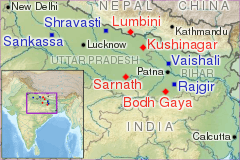
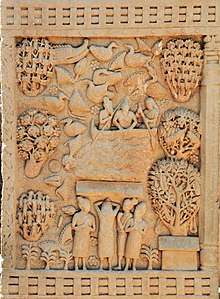
.jpg)